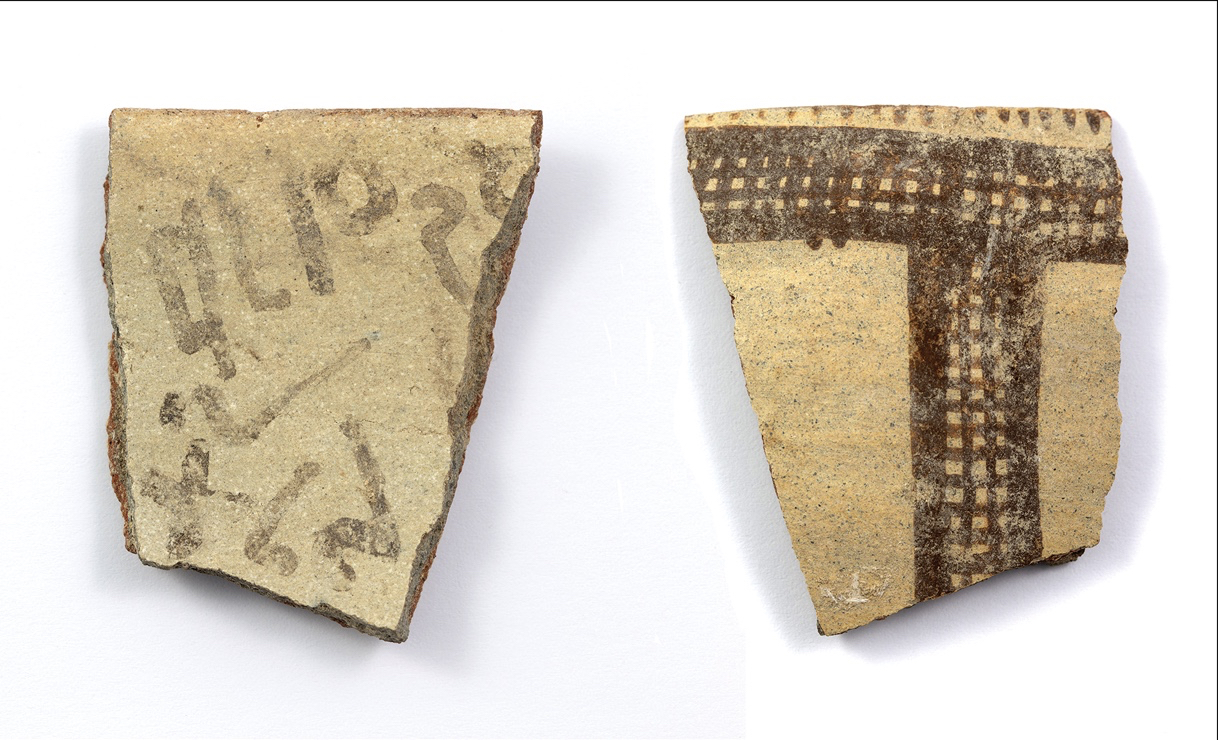
This article is available to Premium members of Popular Archaeology.
Become a member or upgrade to a Premium membership: REGISTER HERE.
Member Login:
This is the example article

This article is available to Premium members of Popular Archaeology.
Become a member or upgrade to a Premium membership: REGISTER HERE.
Member Login:
Kimberly Munro is an Andean archaeologist with over a decade of experience working in Peru. She is the director of the Cosma Archaeological Project, a long-term research project involving excavation and survey in the Andean central highlands, specifically in the Caceres District of Ancash, Peru.
Kimberly earned a dual B.A. degree in Anthropology and Religious Studies in 2007 from Florida State University and also holds a M.S. in Geography (Geographic Information Sciences) from FSU. She received her PhD in Anthropology from Louisiana State University in 2018. Kimberly currently lives in Colorado, where she teaches Anthropology and Archaeology classes, and runs a summer field camp in the canyonlands of Southeast, Colorado through Otero College.
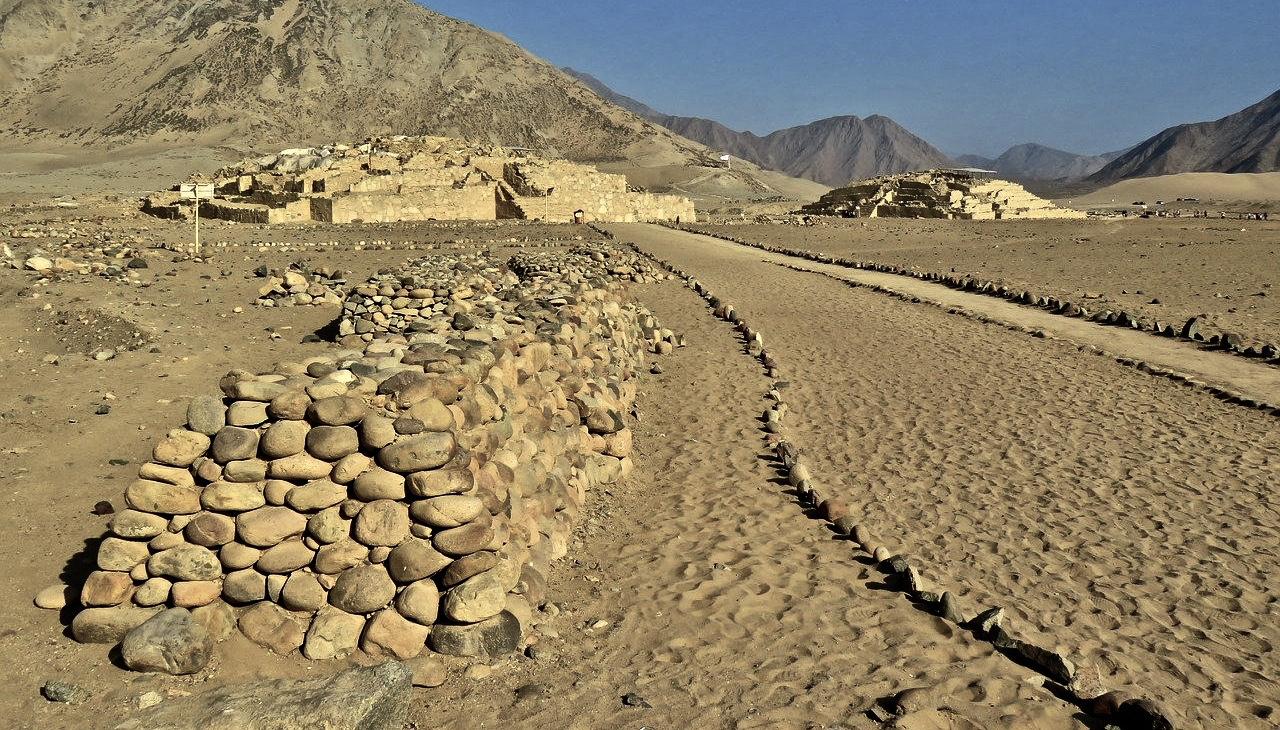
Editor’s Note: When people generally think of the beginnings of ‘advanced’ civilization—that is, the oldest places in the ancient world featuring spectacular monumental structures, sophisticated artwork, and the other common attributes of such societies—ancient Egypt and Mesopotamia come immediately to mind. Next we think of civilizations such as Mesoamerica, the Harrapa, or Indus Valley, and China. In fact, however, significant monumental centers and pyramids were already arising in South America, most specifically in present-day Peru, during the 3rd and 4th millennium BCE—even before the earliest pyramids of ancient Egypt and the earliest ziggurats of Mesopotamia. Advancing the general public profile of these earliest developments in ancient Peru is substantially overdue…………
Archaeologists have long debated the origin and evolution of state level societies across the world. When does a culture become a state? What are the criteria that mark a state? How did states traditionally develop and expand? Was their development driven by a boom and surplus caused by agricultural developments, warfare, the need to manage communal projects associated with water and irrigation, or was it a more religiously based shift? “Civilization” as we understand it — that is, cultures associated with large scale state-level societies (complex, hierarchical, typically with a ruling class, and elites) — originated independently in 6 geographic areas around the world: Mesopotamia, the Nile River Valley (Egypt), Harappa or the Indus River Region, China, Mesoamerica, and the Andes in South America. Typically, at least for archaeologists, this is marked in the archaeological record by large scale public architecture (or communal buildings), a shared or “state” sponsored religion, a move to intensive agriculture, and a form of writing, or record keeping.
The Rise of Early Andean State Societies: The Coastal Story
This article discusses state development throughout the central Andes by showcasing the earliest monumental complexes and their associated cultures in Peru, the region that would one day give rise to the Inca Empire. For the Andean region specifically, the origins of state development has long been debated. The Andes is a peculiar case study, given that unlike the other 5 “cradles of civilization” mentioned above located throughout the rest of the Prehistoric world, Andean state development did not rely entirely on an agricultural revolution. Large scale public monuments are found along the coast by at least 3700 BCE, and many early centers, especially in the highlands, predate intensive agriculture. We know early humans were in South America at least by 13,000 years ago. These early dates are associated with hunter gatherers who lived in small bands, with one of the earliest of their associated sites, known as Monte Verde, located in the tip of Southern Chile, yielding artifacts associated with a foraging village. By 10,000 years ago, repeated human occupation, including evidence for a variety of crops, faunal and textile remains were found in Guitarrero Cave, in the Peruvian highland valley known as the Callejon de Huaylas.
This time period is referred to as the Preceramic, given the lack of ceramics in the archaeological record. The Pre-ceramic can be divided up into Early (13,000-8,000 BCE), Middle (8,000-3000 BCE), and Late (3000-1800 BCE), based on differing categorical markers and cultural developments.
By 7000 BCE, during the Middle Preceramic, more permanent settlements developed along the northern coast – in the Zana Valley. Small scale mounds point to communal architectural constructions above that of the familial, or household level in this region. Known as the Nanchoc Tradition, these sites are marked by a number of low cemetery mounds, and suggest more permanent claims to the landscape, as well as a level of communal bonding, given the shared construction and burial of the dead within the mounds.
The Nanchoc tradition has been identified based on early cemetery mounds constructed well before the adoption of large-scale agriculture. Dating to 5700 BCE, these mounds are attributed to a group of people who were still considered nomadic, only taking part in incipient horticultural practices on a seasonal basis (Dillehay et al. 1997: 46). The construction and use of the Nanchoc mounds likely came before more permanent settlements in the region. The effort to build and bury the dead within these mounds illustrated that groups had an element of communal and ritual life associated with claiming and returning to the specific landscape in this area, and these structures are some of the earliest permanent indicators of broader communal ties and planning efforts.
While the Nanchoc Tradition demonstrates some of the earliest examples of communal constructions “above the house-hold level,” and some of the earliest ties/claims by sedentary populations to specific landscapes, the largest and earliest known Late Preceramic monuments of significant size and complexity are found after 2800 BCE, with the construction of the site complexes of Aspero, followed by El Paraiso. For El Paraiso, located only 2 km off the coast in the Chillón River Valley, this center is 60 hectares in size and includes 13 platform mounds, seven of which are organized to make up a central group, which form or outline a U-shaped plaza.
The dates for El Paraiso place its occupation as early as 2300 BCE (Quilter 1985, 1991), but despite its 13 mounds and planned construction, the nearby site of Aspero predate this complex by at least 500 years. It is made up of at least 17 pyramid mounds, six of which were centrally located pyramids organized to form a central plaza, while the individual mounds measured up to 10 m in height (Feldman 1980). The two largest mounds, Huaca de los Sacrificos and Huaca de los Idolos were decorated with clay friezes, had rooms over 10 m square in size, and stone walls over a meter thick. The Aspero complex dates back to 2800 BCE. The organization and monumental pyramids at both these complexes have been used by archaeologist Robert Feldman (1980) to argue for a chiefdom level society at least by this time, due to the size, complexity, and organization of these platform mounds.
_____________________________
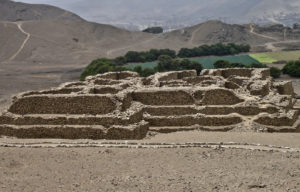
Huaca El Paraiso, located in Ventanilla. Marcogg, Creative Commons Attribution-Share Alike 4.0 International, Wikimedia Commons
_____________________________
Norte-Chico
For such early dates, there is one region within central Peru that lays claim to the largest concentration of monumental and complex religious constructions. This region is known as the “Norte-Chico” and has been one of the most informative and influential zones for understanding Preceramic developments on the coast. Consisting of four separate river valleys, (from north to south: Fortaleza, Pativilca, Supe, and Huaura), by the Late Preceramic, at least 30 distinct ceremonial centers were located within this region (Creamer et al. 2007). Sites among these rivers are situated along the coast as well as inland and include some of the earliest evidence for large scale Preceramic monumental constructions, leading some archaeologists to believe that Norte Chico was the epicenter for innovation and more centralized social complexity within the Andes (Haas, Creamer, and Ruiz, 2005).
The site of Caral, located 16 km from the coast within the Supe Valley, is considered one of the most important of these early Preceramic centers on the coast, and is also currently classified as the capitol of the Norte-Chico culture. Caral dates back to 2800 BCE, and at the time of its initial carbon dating in 2006 was referred to as “the oldest city in the New World” (Shady 2006). The center includes six different monumental platform mounds measuring between 10 and 18 m high, three sunken circular plazas, a large centralized plaza, a number of smaller mounds, architecture which was arranged symmetrically, as well as an associated domestic area, making up a total complex area of 110 hectares. Eighteen similar sites dating to the same time period can also be found in the Supe Valley, though none are as large as Caral. Because of its size and architecture, Caral is considered by some archaeologists to be the “capital” city of what is now known as the “Caral-Supe Civilization.” This “civilization” includes the other Preceramic sites in the Norte-Chico region, as they exhibit a similar pattern which included large platform mounds and associated sunken circular courts, or plazas.
Caral’s largest mound, now referred to as the “Main Pyramid (Piramide Mayor),” was extremely complex. Measuring 18 meters high, the pyramid had a 10 meter wide stairway that connected a sunken plaza to the top of the mound. There, a large hearth within an atrium was excavated. Another large mound was associated with a sunken plaza, now classified as an “amphitheater” due to the number of associated musical instruments found during excavation (32 pelican and condor bone flutes and 37 trumpet-like instruments made of deer and llama bones.). This sunken plaza was associated with a large rampway leading up to the entrance, and surrounded by semi-circular, short walls, which have been interpreted as possible seating around the plaza. While this mound is smaller than the Main Pyramid, its sunken plaza is much larger. This may indicate that this plaza specifically was utilized for performative, or ritual dancing and music.
Caral’s inland location made it especially productive for farming cotton and other gourds, beans, and chilies. Cotton was extremely important to coastal societies. It was used for their fishing nets, textiles, clothing, containers, and shicra bags. These shicra bags were utilized to carry small bundles of rocks, which were brought in to construct the temples and pyramids at the site, acting almost as sand bags. The productive farming in the region allowed the people of Caral to trade with sites directly on the coast, like Aspero, for salt, mollusks, sardines and anchovies. Caral’s location was also situated for exotic trade with the highlands, making the center productive enough to outgrow Aspero in size and influence. The relationship between Caral and Aspero has led researchers to develop the “Cotton for Fish” model to explain the connections between inland and coastal sites. The theory states that cotton and agricultural crops were grown inland at and around sites like Caral. The cotton at least, was traded to people living on the coastal fisher sites, so these communities could make their nets for fishing traded back to the inland communities to supplement their otherwise plant-based diets (Haas et al. 2005).
_______________________________
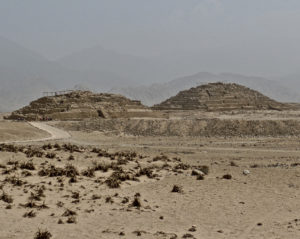
Above and below: Views of the pyramidal structures of Caral. Kimberly Munro
_______________________________
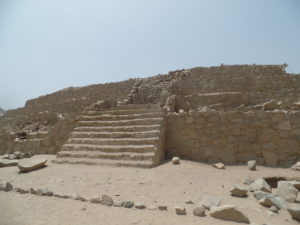
_______________________________
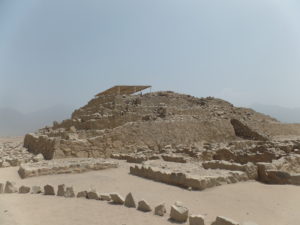
_______________________________
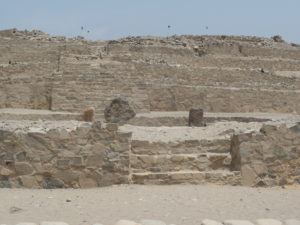
_______________________________
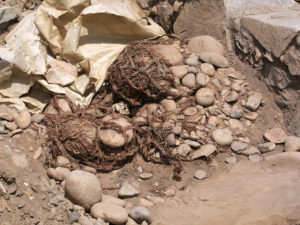
Shicra bags found on location at Caral. Håkan Svensson Xauxa, Creative Commons Attribution-Share Alike 3.0 Unported license, Wikimedia Commons
_______________________________
Earlier Sites
As research continues in the Norte Chico region, new sites with earlier dates have been added to the archaeological dataset. The site of Bandurria is one of these centers. Located along the coast in the Huaura valley and constructed in a similar pattern and style as Caral, the site dates back to 3200 BCE, earlier than Caral (Chu 2008). Bandurria includes two sunken circular plazas, stairways and other terraced/pyramidal mounds. Additionally, the site of Huaricanga in the Fortaleza valley has now been determined to have even earlier dates — around 3500 BCE — making it the earliest in the Norte Chico region. Due to the number of such early dated sites in Norte Chico, several archaeologists have concluded that the beginnings of Andean “civilization” must have started in this region (Haas and Creamer 2006; Piscitelli 2014).
________________________________
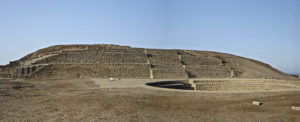
Above and below: View of the Late Temple at Bandurria archaeological site. It includes the truncated pyramid and the circular sunken plaza. Guillermo Arévalo Aucahuasi, Creative Commons Attribution-Share Alike 3.0 Unported, Wikimedia Commons
________________________________
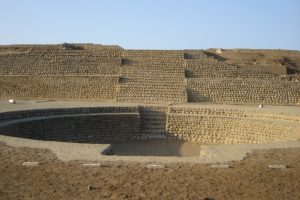
________________________________
While the Norte-Chico area was home to the largest concentration of Late Preceramic monumental centers during this time, architectural and complex developments in the Casma Valley, located just a two-hour drive north along the Pan-American highway, cannot be overlooked. The Casma River Valley has been heavily researched and excavated, due to a number of early centers, mostly associated with the following Initial Period (1800-900 BCE), and significant architectural developments following the Preceramic Period. While Casma’s apex appears to have occurred during the Initial Period, several monumental antecedent centers have been noted for the Preceramic Period. One of the earliest sites to date with complex monumental architecture is known as Sechín Bajo. Located 12 km inland from the Pacific coast and composed of three constructed mounds, corporate construction at the center, which dates as early as 3600 BCE, consists of a mix of stone and adobe elements. These early dates were associated with a sunken circular plaza and a two-meter-tall frieze and was excavated by archaeologist Peter Fuchs (2008.)
_________________________________
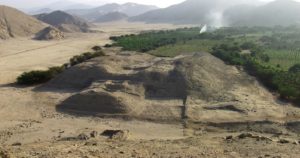
Sechin Bajo. Rickray1870, Creative Commons Attribution-Share Alike 4.0 International license, Wikimedia Commons
_________________________________
The Late Preceramic for Casma is also known from the centers of Las Haldas, and Huaynuna. Las Haldas, another monumental center, is located 20 km south of the Casma Valley and has been intensely studied. First reported by Engel as a Preceramic site in 1958, research has been conducted by two separate Tokyo Expeditions, Rosa Fung, Terence Grieder, Edward Lanning, and Thomas and Shelia Pozorski. The site itself was initially reported by Engel to include six terraces, constructed in “the shape of a jaguar” (Matsuzawa and Shimada 1978: 653), and the terracing at the center has been referred to as a “temple complex.” Located only 100 m from the Pacific coast, Las Haldas is composed of midden deposits and a large mound surrounded by a series of smaller mounds (Pozorski and Pozorski 1987: 16). Throughout the different excavations, three separate Preceramic midden areas were also exposed.
_____________________________
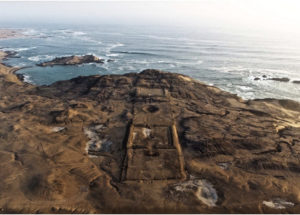
Aerial view of Las Haldas. Proyecto Arqueológico Las Aldas, Creative Commons Attribution-Share Alike 4.0 International license, Wikimedia Commons
_____________________________
Finally, the site of Huaynuna, also located on the Casma coast, includes a large midden, smaller domestic structures, and a “substantially terraced hillside structure” that was interpreted as a small temple complex. Interestingly, the Pozorskis have found evidence for two distinct ritual traditions at this Late Preceramic site. The first included utilizing the temple complex for public/communal rituals, and the second involved a small ventilated hearth structure similar in size and composition to the private ritual constructions associated with the highland Kotosh-Mito (discussed later in this article) tradition (Pozorski and Pozorski 1987, 1990: 17). Huaynuna has been dated to between 2250-1510 BCE (Pozorski and Pozorski 1990: 20). Huaynuna differs from the other Late Preceramic centers mentioned above due to its smaller size and lack of monumental architecture, indicating it was most likely a small but mostly permanent seaside village, as opposed to a monumental ceremonial center.
The Rise of Early Andean State Societies: The Highland Story
While the coast saw the introduction of large pyramid mound constructions associated with sunken circular plazas (e.g., Norte Chico area, Casma Valley, Salinas de Chao), the highlands were home to a very different architectural tradition. In the central highlands, emphasis was placed on complexes that included clusters of small privatized rooms with single entranceways (Burger 1992: 51). Known architecturally as the Mito or Kostosh tradition (henceforth referred to as Kotosh-Mito), this phenomenon focused on small, closed temple structures, each with a central hearth, low level benches, and niches located along the walls, potentially for the placement of offerings (Bonnier 1987; Burger and Salazar Burger 1980, 1985). Kotosh-Mito structures have been found throughout the Department of Ancash region—mainly in the highlands, at the sites of Kotosh, Shillacoto, Huaricoto, La Galgada, Piruru, el Silencio, Chavín de Huántar and Hualcayan (Bonnier 1997; Bria 2017; Burger and Burger 1985; Contreras 2010; Grieder et al. 1988; Izumi and Sono 1963; Izumi et al. 1972; Montoya 2007; Quilter 1991).
The Kotosh-Mito tradition was originally named after the type site of Kotosh, the first site of its kind to be excavated, located in the Huánuco Valley in the central highlands. Kotosh consists of multiple temple mounds, which were first dug in the 1960s by the Japanese expedition in Peru (Izumi and Sono 1963; Izumi and Terada, 1972).
These initial excavations revealed numerous shrine-like rooms, which included interior wall niches and mud relief friezes decorating the temple walls. Additionally, these rooms were built with sunken floors with central hearth features. Each room has been interpreted as an individual temple chamber, differing from the large scale plazas found along the coast at this time. The highland religion, based on architectural evidence, suggests smaller scale ritual activity. Interestingly, before a room was abandoned it was ritually sealed off through a process known as “temple entombment” (Matsuzawa 1972). Temple entombment involved the taking of sterile soil and rocks to seal off the structure, closing it off completely with a clay capping before constructing another temple over the original chamber.
Two of the chambers at Kotosh are unique from other rooms associated with the Kotosh-Mito tradition. One of these is a large temple structure referred to as “The Temple of the Niches,” (Templo de los Nichitos) due to the large number of niches that were constructed in the chamber walls. The Temple of the Niches measured 8.5 x 9.5 m in size and included 23 wall niches, a split-level floor, and burnt offerings found within the central fire feature. Directly below this chamber is the best preserved room at the site, known as “The Temple of the Crossed Hands,” (Templo de la Manos Cruzados). Named as such due to the clay frieze representing two crossed hands, this room is square in shape and measured 9.5×9.3 m in size. The intact walls stood 2 meters tall, and like the other Kotosh-Mito structures, there is a central hearth and split-level floor, as well as over 30 niches. The clay frieze exposed in this room displays two pairs of crossed hands. The hands are symmetrically placed within the room, however there is a difference in size, one larger than the other, suggesting a dual element of masculine/feminine within the Kotosh-Mito ideology.
Excavations at Kotosh further revealed that some rooms were re-utilized, repaired, and altered several times before being ritually closed off. The process of ritual entombment often left a honeycombing of chamber rooms within a site, and the mounds often grew gradually over time, as rooms were sealed off and new platforms constructed.
Dates at Kotosh and the nearby site of Shillacoto place their occupational use well within the Preceramic and Initial Period (2000-1000 BCE.). While the sites of Kotosh and Shillacoto were some of the first of their kind to be excavated, they were not the earliest of these centers to be constructed. To date, one of the earliest known Kotosh-Mito complexes is the site of Huaricoto, located in the Callejon de Huaylas, outside of the town of Carhuaz.
_____________________________
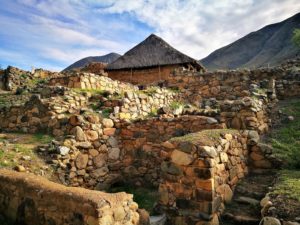
Above and below: The remains of Kotosh. Pitxiquin, Creative Commons Attribution-Share Alike 4.0 International license, Wikimedia Commons
_____________________________
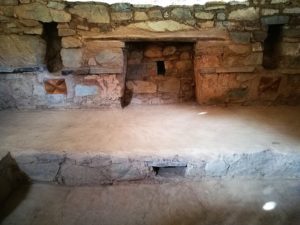
A view inside the Temple of the Crossed Hands. Note the crossed hands frieze at lower left.
_____________________________
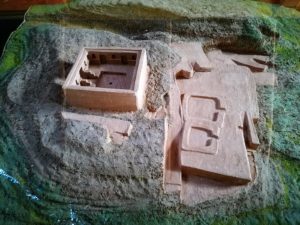
Model of the temple complex at Kotosh, as displayed in the museum.
_____________________________
Huaricoto was occupied well into the Early Horizon (900-200 BCE), however, the earliest date comes from a carbon sample taken from a central hearth in one of the rooms, dated to 2430 cal BCE. Excavations at Huaricoto revealed at least 13 different structures with a similar pattern to those constructions at Kotosh and Shillacoto, including split level floors and central fire features.
While Huaricoto may have the oldest dates for Late Preceramic highland chambers, for Kotosh-Mito researchers, La Galgada may be one of the most intriguing centers, not only for its early dates and long occupation, but also for the quantity and preservation of the different temple chambers found throughout the site. Located on the Tablachaca branch of the upper Santa River Valley at 1,100 masl in the Department of Ancash, La Galgada is known for its dual mounds, Mito style temples, and a sunken circular plaza (a unique addition not present at the other Kotosh-Mito highland sites). The circular plaza links coastal architectural canons with highland components. Excavated by Terence Grieder, the site’s location along major coastal highland trade-routes may account for its shared styles, as evidenced by a number of exotic trade items recovered from the site (Grieder et al. 1988). La Galgada is to date an exceptional example in its abundance of Mito architecture. The rooms at La Galgada were rectangular with rounded corners and included wall niches, split level floors, central fire features, and single entrances (Grieder el al. 1988). Dates for La Galgada range from 3000 to 1700 BCE, however, the base of the mound and presumably earliest constructions were never reached, indicating there may be earlier structures deep within the complex. The largest mound, known as the north mound, measured 15 m in height at its peak and revealed a unique burial tradition not documented at any other Kotosh-Mito centers. As each temple structure was sealed off, it was re-utilized as a burial space, sometimes housing multiple individuals at a time. Access into many of these rooms were kept open for multiple generations, and a shaft or gallery was constructed after the room was sealed in order to keep access open to the individuals buried within. New burials were continuously added until the room would finally be sealed off, and new chambers were built above these structures.
_______________________________
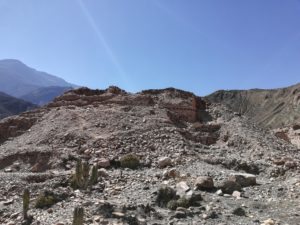
Above and below: Views of La Galgada. In the picture below, if you look closely, you will see the author (in red) perched amidst the remains of the mound. This shows the massive scale of the structure. Kimberly Munro
_______________________________

_______________________________
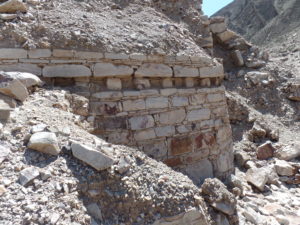
_______________________________

_______________________________
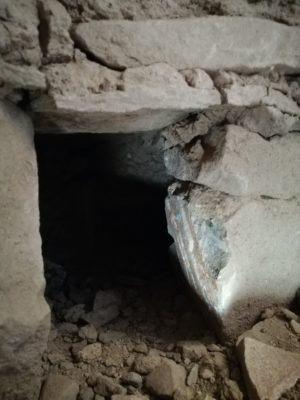
_______________________________
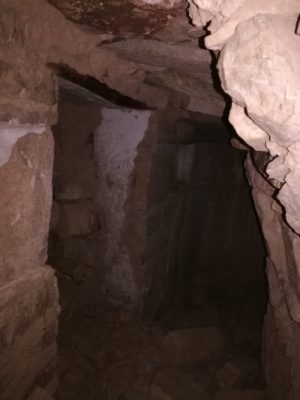
_______________________________
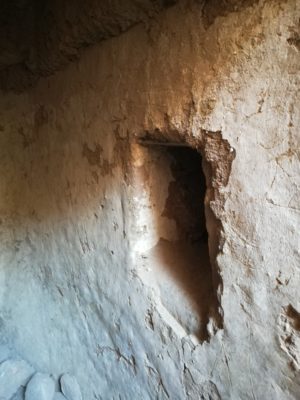
_______________________________
In total, there are 7 sites in and around the highlands of Ancash and Huanuco that are associated with Kotosh-Mito architecture: Kotosh, La Galgada, Huaricoto, El Silencio, Piruru, Hualcayan, and the Cosma Complex. Dates for these complexes range from the Late Preceramic and into the Initial Period. Comparatively, the quantity and megalithic features of coastal sites far outweighs the sample size recorded to date for the highlands. A number of archaeologists have interpreted this as evidence for civilization originating along the central coast, mostly in the Norte-Chico region (mainly due to the rich marine resources associated with the coastal sites, which could support large populations, cities, and more complex life-ways). The early dates and repeated occupation at Guitarrero Cave, however, paired with new research in the highlands, may indicate that highland developments were equally complex and contemporaneous with the earliest monumental constructions along the coast.
The next article in this series will focus specifically on one such recently documented center — the Cosma Complex. Cosma is unique in its location, situated outside of the traditional Kotosh-Mito cultural zone. Featuring a mixing of highland and coastal elements, Cosma’s appearance may add a new classification of sites, bridging a gap in our knowledge of Late Preceramic development and interaction networks in the Andes. As readers will see in the next series installment, the early dates from Cosma may also suggest a reworking of our understanding of state development in the Andes — that it most likely did not originate exclusively in a central locale, either on the coast or the highlands, respectively. Interactions between the two regions were most likely continuous and more fluid than researchers originally may have posited.
Cover Image, Top Left: View of the site of Caral. JDBENTHIEN, Pixabay
___________________________________
 In the future, article author Dr. Kimberly Munro will be leading groups to see many of the sites discussed in this article, plus many more. If you are interested in participating in this activity, please send an email expressing your interest to populararchaeology@gmail.com. As this project is developed, you will be informed of the details and provided the opportunity to register your place with the group. You can also follow Dr. Munro’s archaeology updates on Instagram @the.field.professor. Pictured here, Dr. Munro is on location at La Galgada.
In the future, article author Dr. Kimberly Munro will be leading groups to see many of the sites discussed in this article, plus many more. If you are interested in participating in this activity, please send an email expressing your interest to populararchaeology@gmail.com. As this project is developed, you will be informed of the details and provided the opportunity to register your place with the group. You can also follow Dr. Munro’s archaeology updates on Instagram @the.field.professor. Pictured here, Dr. Munro is on location at La Galgada.
___________________________________
Arianna Zakrzewski is an intern and writer for Popular Archaeology. She is also a graduate from Rhode Island College with a Bachelor’s degree in Anthropology. She has had an interest in archaeology since elementary school, specifically Egyptology and the Classics. In recent years, she has also gained an interest in historical archaeology, and has spent time in the field working in St. Mary’s City, Maryland, participating in excavation and archival research. Most recently, she completed her MA in Museum Studies from Johns Hopkins University. She is currently focused on collections management and making archaeological discoveries accessible and exciting to the public.
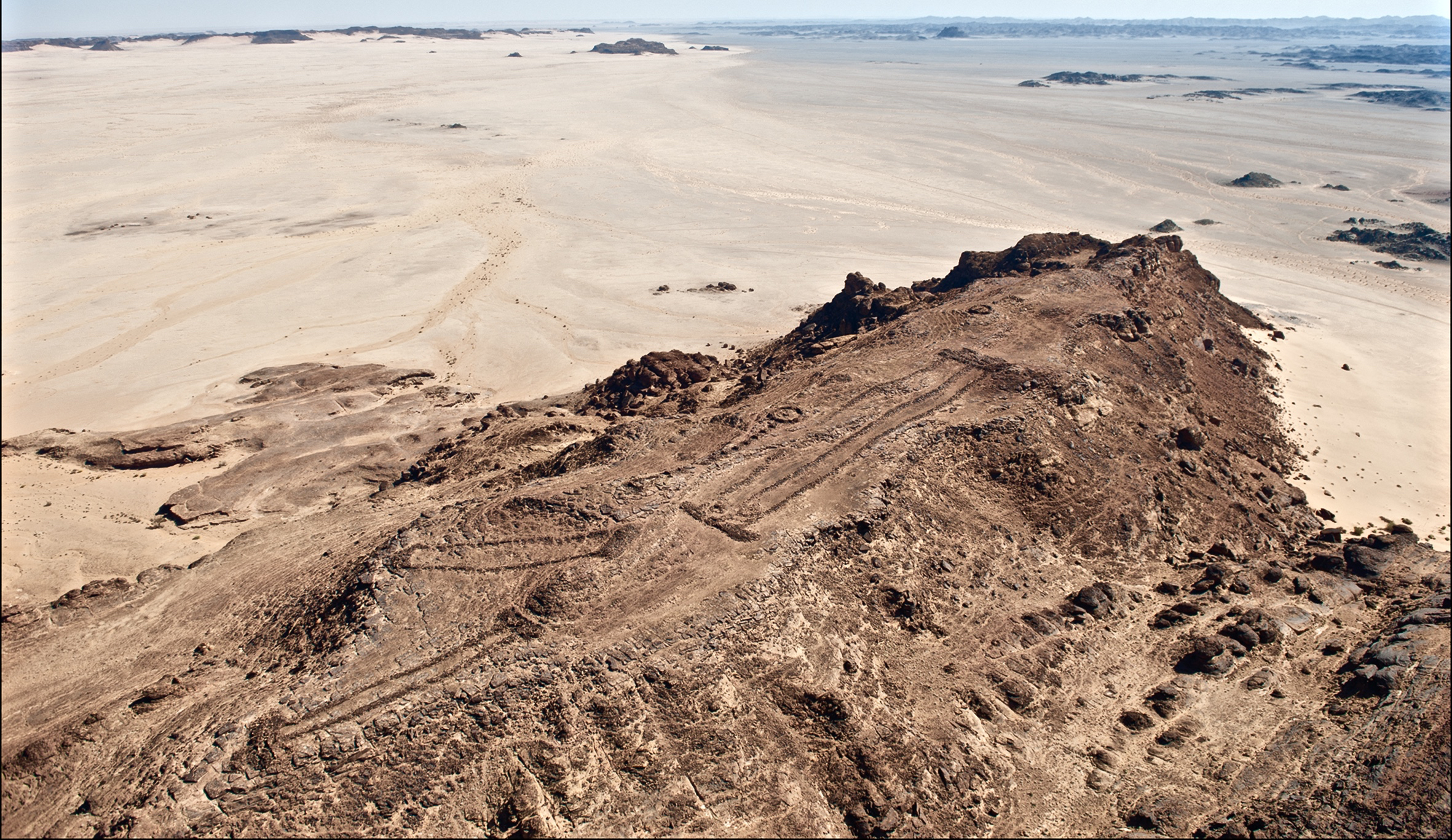
Most archaeologists would say that the Neolithic, a time period between 10,000–4,500 BCE, was best characterized by the beginnings of agriculture and fixed human settlements. These people were not known for their massive architectural achievements and monuments. But a recent excavation led by a team of archaeologists from the University of Western Australia has shed new light on ancient monumental structures dating back over 7,000 years ago, located in present-day Saudi Arabia.
Known as “mustatils,” named after the Arabic word for rectangle, these structures have been the subject of very little research, despite the fact that they are not a recent discovery.
“We started excavating in 2019 as it was the natural progression of our work in the region,” explains Dr. Melissa Kennedy, one of six researchers working on this excavation. “Once we had found out how these structures were formed it was important to be able to date them.”
The team documented hundreds of mustatils aerially, explored almost 40 on the ground, and excavated one, making this the largest study ever conducted on these structures. According to the project’s director Dr. Hugh Thomas, in an interview for Antiquity, over 1,000 mustatils were documented during this project, covering over 200,000 km2 in northwest Arabia.
Dr. Kennedy notes, “Our project started off as purely aerial photography and after viewing our photos of these structures we began to realize that these features were extraordinarily well preserved and that we needed to visit them on the ground. That is when we really began to realize how complex these structures were. Having the aerial photography component of our project is unique, as this allows us to get a different perspective on the archaeological remains we are documenting.”
“We use a variety of techniques; remote sensing, using publicly available satellite imagery, aerial photography, ground survey, and traditional excavation,” she explains. “We also used a lot of digital technologies, such as orthophotography, which is a highly accurate photo mosaic created from hundreds of aerial photographs, and drones. The main challenge with this site is that the structure was made of a type of stone that was highly degraded. It made work in the head of the structure very difficult and very hard to define the chamber.”
______________________________
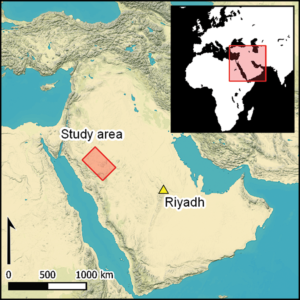
Map showing location of study area in Saudi Arabia. AAKSAU
______________________________
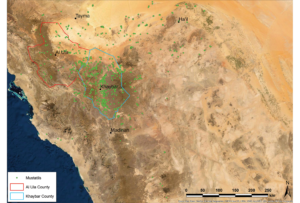
Mustatil distribution across northwestern Arabia. AAKSAU
______________________________
This research has more than doubled the total known number of mustatils in Saudi Arabia and established that these structures were far more architecturally complex than previously supposed. Cattle horns and skull parts were uncovered at the site as apparent offerings, confirming assumptions that the structures were built for rituals. Cattle was a vital part of the lives of early humans in the region. Evidence of ‘cattle cults’ have been found in southern Arabia around 900 years later, making it reasonable to conclude that these more ancient mustatils may have been an early example of these cults.
The number and consistency of mustatils in northwest Arabia suggests to researchers that these beliefs were widespread across the region. Given their size and number, they were likely large groups of people coming together and organizing to erect these ritual sites, creating the oldest monumental landscape of this scale ever identified, predating the pyramids of Egypt and Stonehenge in Britain.
“We hope to gain a broader insight into the cultic landscape of northwest Arabia in the late Neolithic,” says Dr. Kennedy. “Particularly, why were these large cultic structures built, what were the beliefs of these people and why did this tradition die out?”
____________________________

A group of three mustatils. AAKSAU and Royal Commission for AIUIa
____________________________
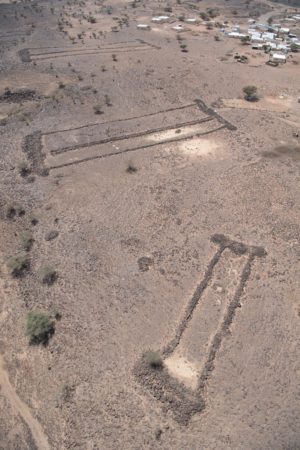
Mustatils from the Harrat Kaybar, Saudi Arabia. AAKSAU and Royal Commission for AIUIAa
____________________________
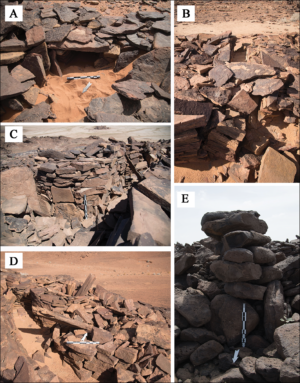
Features of a mustatil: (A) Internal niche located in the head of mustatil; (B) a blocked entranceway in the base of a mustatil; (C-D) associated features of a mustatil: cells and orthostats; (E) stone pillar identified on the Harrat Kaybar lava field. AAKSAU and Royal Commission for AIUIa
____________________________
While the findings of the excavation shed light on the ritual traditions and community organization of this region, they also offer more information on the wildlife at the time. Dr. Kennedy explains, “The animal horns are extraordinarily well preserved; they are very important as they give us an insight into the type of cattle being herded in the region in a way that the bones do not.”
“From our perspective, the most significant finds from our work have been from the mustatil and the collective burial we excavated that featured the earliest domestic dog in Arabia,” notes Dr. Kennedy. “For the mustatil, articulating the different facets of these structures has been very important. With the collective burial, we identified multiple phases of use and significant animal offerings. This is some of the earliest evidence for this in northwest Arabia.”
_____________________________
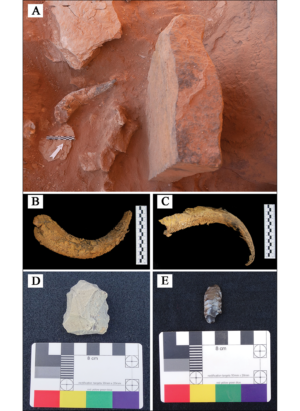
Artifacts recovered during excavation and ground survey: (A) cattle horn positioned in front of a betyl; (B-C) recovered cattle horns; (D) collected Neolithic micro core; (E) Neolithic bifacial foliate. AAKSAU and Royal Commission for AIUIa
_____________________________
Excavations at this mustatil site have concluded, but the team hopes to begin at another mustatil site in the near future to compare their results.
_____________________________
*Thomas, H., Kennedy, M., Dalton, M., McMahon, J., Boyer, D., & Repper, R. (2021). The mustatils: Cult and monumentality in Neolithic north-western Arabia. Antiquity, 95(381), 605-626. doi:10.15184/aqy.2021.51 https://doi.org/10.15184/aqy.2021.51
All images: http://creativecommons.org/licenses/by/4.0/
_____________________________
Advertisement
Eberhard Zangger (born 1958 in Kamen, Germany) is a Swiss geoarchaeologist, corporate communications consultant and publicist. Eberhard Zangger studied geology and paleontology at the University of Kiel and obtained a PhD from Stanford University in 1988. After this he was a senior research associate in the Department of Earth Sciences at the University of Cambridge (1988–91). He is currently president of the board of trustees of the international non-profit foundation Luwian Studies.
In May 2016, Luwian Studies went public with a website in German, English and Turkish. As part of its research, the foundation has systematically catalogued extensive settlement sites of the Middle and Late Bronze Age in Western Asia Minor. These sites are presented in a public database on the website. The foundation provides financial support for archaeological excavations and surveys, as well as for linguistic studies dedicated to the cultures of the Middle and Late Bronze Age in western Asia Minor.
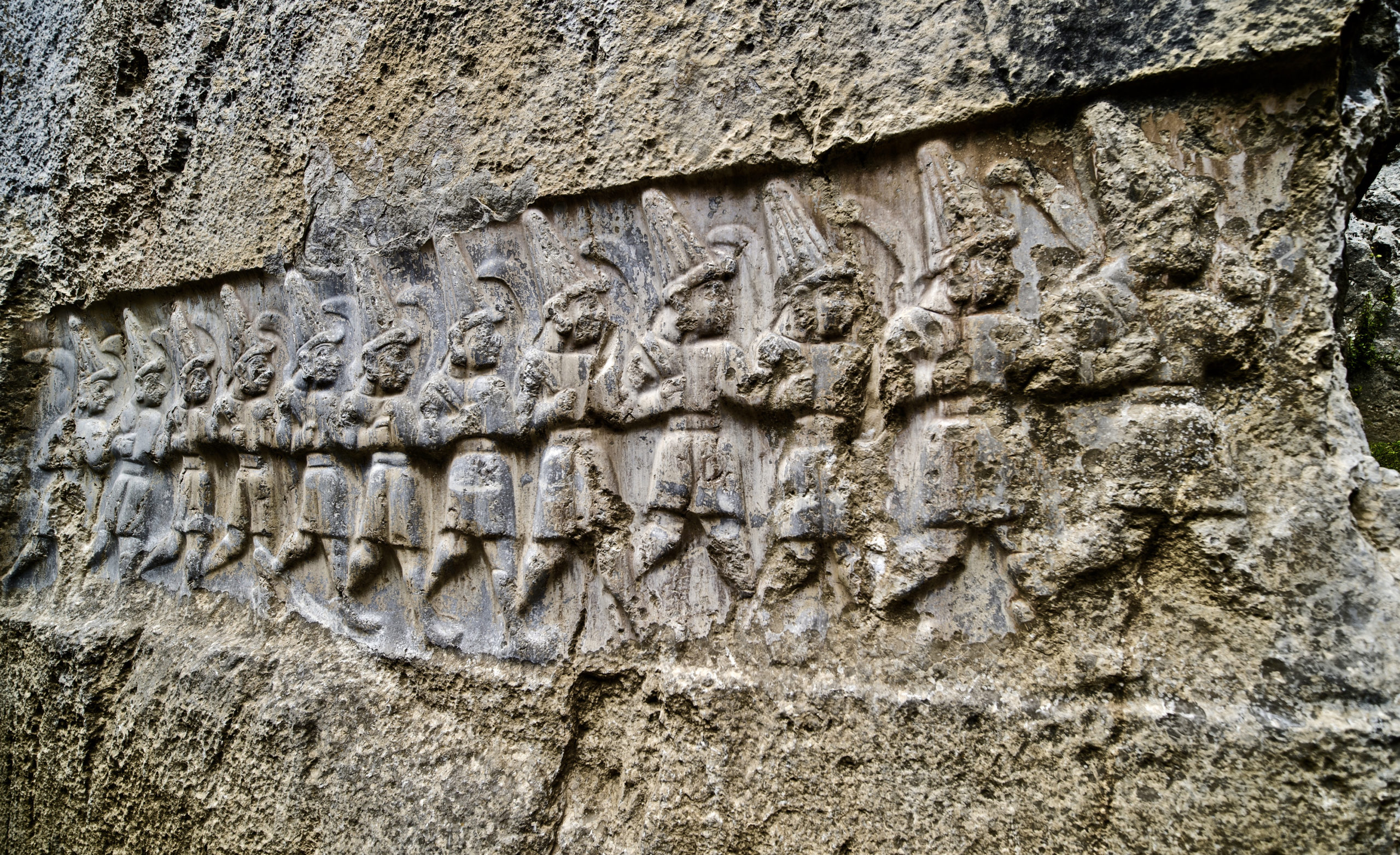
For almost 200 years, archaeologists, art historians, and philologists have tried in vain to find a plausible explanation for the unique and well-hidden rock sanctuary of Yazılıkaya, adjacent to the former Hittite capital Ḫattuša in central Turkey. Both the ruins of the city and the sanctuary with its many reliefs carved into the natural stone have been listed as UNESCO World Heritage Sites since 1986. They are the impressive remnants of a once powerful kingdom that ruled over Central Anatolia from around 1650 to 1190 BC, and whose kings were at times on a par with the mighty pharaohs of New Kingdom Egypt.
In June 2021, for the first time, an international team comprised of archaeologists, astronomers, and ancient historians have advanced a plausible explanation for the meaning of each of the more than 90 artistically carved reliefs of mythical figures and anthropomorphic deities, documented in detail in the Journal of Skyscape Archaeology. In short, they posit that the rock sanctuary symbolizes the cosmos as the Hittites imagined it. They suggest that the reliefs illustrate the three main elements of cosmic order: the earth, the sky, and the underworld. They show how these levels, and thus all portions of the cosmos, were populated by deities. In the Ancient Near Eastern belief system, the cosmic order was stabilized through constant renewal, with celestial regularities setting the pace. Renewal occurs when after a dark and cold night the sun rises to bring a bright and warm day; when from a dark moon a full moon gradually waxes; and when the withering away of vegetation and the inhospitable winter months are succeeded by blooming plant cover of spring and summer. Yazılıkaya reflects these cosmic cycles so systematically that the sanctuary can still be used as an accurate calendar.
_________________________________

The ancient remains of Hattuša. The foundations of Temple 3 (foreground left), Temple 2 (right), and the king’s palace at Büyükkale (background) catch the first rays of the rising sun on the day of the winter solstice
2018 in the upper city of Hattuša (© Luwian Studies #1015).
_________________________________

The main scene in Yazılıkaya’s Chamber A is where the processions of deities coming from
the left and from the right meet on the local meridian (© Luwian Studies #1216).
_________________________________
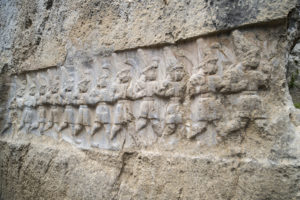
Twelve identical male gods in Chamber B carrying sickle-shaped swords (© Luwian Studies
#1233).
_________________________________
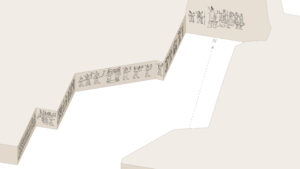
Schematic drawing of the reliefs of deities on the western wall and main panel in Yazılıkaya’s
Chamber A (© Luwian Studies #1404).
_________________________________
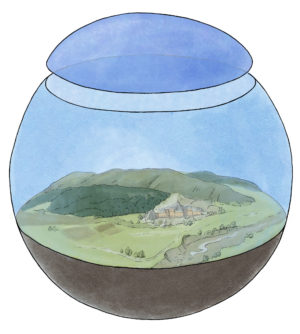
The four elements of the Hittite cosmos as symbolically depicted in the rock sanctuary of Yazılıkaya: underworld, earth, sky, and celestial circumpolar zone (© Luwian Studies #1418).
_________________________________
Egyptian Connotations
Some components of the sanctuary can be traced back to Sumerian and Old Babylonian traditions. The procession of the deities on the western wall, for instance, shows a clear hierarchical order in which the higher-ranking gods are identified with their names – some of which are Babylonian – written in Luwian hieroglyphics. This is a rare example of this script being used to express another language, namely Hurrian. Appropriations from neighboring cultures are obvious: the Luwian (Western Anatolian) writing system, the Hurrian language, and the Babylonian deities mixed in with those from the Old Anatolian tradition.
However, thus far, little attention has been paid to borrowings from Egypt, which are also frequent. The entire Luwian hieroglyphic system arose long after the Egyptian script and contains some signs from the Egyptian repertoire. The symbol of the winged sun disk, for example, is the epitome of Egyptian iconography. One relief in Yazılıkaya shows how the Hittite great king is embraced by his protective deity Šarruma – a scene known from two Hittite seals but that also reflects a longstanding Egyptian tradition. In Yazılıkaya, the days of the lunar months are depicted as individual deities in a way that reflects earlier and later Egyptian temple decorations.
What is completely new in the recently presented model is the interpretation of the main panel as a reference to the northern circumpolar region of the night sky. Constellations in this part of the sky dome never disappear below the horizon, and were thus considered undying. According to several ancient belief systems, the world axis (axis mundi) holding the cosmos together is fixed to the northern sky. In Egypt, people believed that the deceased king’s ba (or soul) traveled to this part of the cosmos after the king had first accompanied the sun god Ra on his twelve-hour journey through the underworld. Much like the walls of Egyptian temples, the reliefs in Yazılıkaya were apparently originally painted in bright colors. An Egyptian-style winged sun disk appears over the head of the Sun god of the heavens; and in a large relief of this deity in an artificially constructed chamber in Ḫattuša, the god is holding a sign that corresponds to the Egyptian key of life (ankh). The lower half of an Egyptian-style pyramid forms a large architectural complex in the highest part of Ḫattuša. This complex even contains a straight vaulted tunnel that is strictly oriented to the north and inclined upward, reinforcing the connection to the northern sky as well as the association with the axis mundi. The meridian obviously assumed a prominent meaning in Hittite cosmovision.
How are these allusions to Egyptian iconography explained? The Yazılıkaya sanctuary in its current form dates to around 1230 BC, though it had predecessors. The natural adytum was sealed off from the surroundings by temple buildings, and these reveal at least three different construction phases. At the time the present sanctuary was built, in the second half of the thirteenth century BC, the royal houses of Egypt and Hatti enjoyed exceptionally close relations. After the Battle of Kadesh (1274 BC) a peace treaty was signed (in 1259 BC) bringing the two royal houses closer together. The relations were so intimate that Pharaoh Ramses II requested from the great king of Hatti, Hattušili III, and his wife, queen Puduḫepa (the most famous, and also the last known, Hittite queen), one of their daughters to become his bride. The Hittite princess Sauškanu was then sent off to the Nile, with her mother accompanying her all the way to the Egyptian border. In December 1246 BC, the princess married the pharaoh, and she was renamed Maathorneferure (“One who sees Horus, the invisible splendor of Ra”).
________________________________
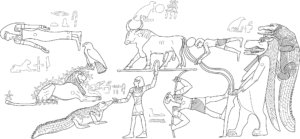
Astronomical ceiling of tomb KV17 of Pharaoh Seti I, reflecting the northern night sky (©
Luwian Studies #5024).
________________________________

Star trails above Yerkapı emphasize the strict northern orientation of the architecture (©
Bernd Pröschold/Luwian Studies #1041).
________________________________
Puduḫepa’s Signature
A few years after the wedding, the princess received her brother Hišmišarruma as a formal visitor in the Egyptian capital Per-Ramesses, in the eastern Nile Delta. The Hittite prince decided to remain through the winter in the region. Yazılıkaya obtained its current form only a few years after this visit. The references to Egyptian iconography could thus well be based on impressions (and perhaps even records) gathered during a period of close family ties between the royal courts. Back in Ḫattuša, Hišmišarruma would have reported in detail about his impressions of the Egyptian court. His brother Tašmišarruma was in line to succeed the king – and Yazılıkaya indeed contains two prominent reliefs of him, dating to the time when he ruled under the name Tudḫaliya (IV). After he had taken the throne, the new king was further advised on questions of religion by his mother Puduḫepa. The sanctuary in its present form thus bears Puduḫepa’s handwriting. Puduḫepa was born at the beginning of the thirteenth century BC in the city of Lawazantiya in Kizzuwatna as the daughter of the chief priest of the city’s patron deity, Ištar; and so Puduḫepa grew into the role of a priestess of the same goddess. About a year after the Battle of Kadesh, the Hittite general Hattušili met Puduḫepa, who was then perhaps only fifteen years old, and took her as his wife. Hattušili eventually usurped the Hittite throne from his nephew Muršili III, and so Puduḫepa became queen. As a priestess, she worked on the organization and rationalization of the Hittite religion. The last phase of these syncretizations was immortalized in Yazılıkaya.
_______________________________
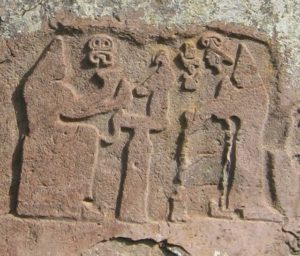
Ancient relief carving showing Queen Puduhepa on the right. Krähenstein, Creative Commons Attribution-Share Alike 3.0 Unported license, Wikimedia Commons
_______________________________

Letter of Friendship written in Akkadian by Naptera, the wife of Ramses II, the king of Egypt, to Puduhepa, the wife of Hattusili III, the King of Hittites, between the years of 1275-1250 BCE. Isabeau, Creative Commons Attribution-Share Alike 4.0 International license, Wikimedia Commons
_______________________________
The Hittite Demise
Around 1190 BC, the sanctuary was abandoned along with the capital. The influence and power of the great Hittite kings had declined over the course of a few generations, primarily owing to disputes within the royal family. The neighboring states of the Hittite kingdom took advantage of the weakness of the central power and from all four sides pushed the border ever further toward the capital. With their constant raids, the Kaška had always dominated the northern border, thereby preventing Hittite access to the Black Sea. Assyrian forces stormed forward to the east, conquering extensive areas including the valuable copper mines of Išuwa. Tarḫuntašša in the south had been a loyal vassal for generations, but even that state appears to have fallen away from the central government and then may have challenged it. In the west, everything depended on whether the small states based there would decide to join forces (against the great king). It was precisely during this fragile time that the so-called Sea Peoples suddenly attacked the coast of Cyprus, an island that the Hittite great king had annexed not long before. Then Ugarit in northern Syria, the last loyal vassal of the Hittite royal house, fell victim to the raids of the Sea Peoples, and Hittite forces found themselves involved in both sea and land battles. Soon after, the ruling class abandoned the capital, taking most movable objects with them or hiding them. The Hittites left most rooms swept clean. As a result, archaeological excavations brought few significant artifacts to light – apart from the extensive archives.
Rediscovery
We know nothing about the fate of the sanctuary between 1190 BC and AD 1834, when, at last, the French archaeologist Charles Texier explored the area in search of forgotten historical cities. Local farmers led him to the hidden shrine, and then he spent time there making sketches to illustrate his discovery. Upon his return to Paris, Texier’s account caused quite a stir among the bourgeoisie, partly because his drawings of the reliefs were grossly exaggerated. Yet that would not have been necessary, because there is no question that Yazılıkaya is a very special place. In the wake of Texier’s report, a number of scholars visited the area in the nineteenth century. They returned with more drawings exhibiting increasing accuracy, including some of the earliest photos.
It would be futile to ruminate on the initial attempts at interpreting the meaning and function of the shrine, which are far-fetched from today’s perspective. It is much more interesting to review the individual aspects that were recognized at an early stage and which have now been confirmed by the latest research. One of the first European visitors to the shrine observed that “those figures furthest removed from the center were perhaps being intended for inferior persons” (Hamilton 1842, 384). The two bull-men in the center of the western procession “appear to carry a barque” (von Ritter 1858, 386), which undoubtedly symbolically indicates a solar eclipse (Barth 1859, 136). Today we know that the symbol resembles the “boat of light” and that it marks the only day of the month on which a lunar eclipse may occur. Some iconographic elements, including the winged sun disk, seem to be derived from Egypt (von Ritter 1858, 392). “The chief figures are represented larger than the rest which is in accordance with Assyrian and Egyptian custom” (van Lennep 1870, 119). The hieroglyphic symbols correspond to those found in Hama and ought to be attributed to the Hittites: “And [they] must be assigned a much higher antiquity than has hitherto been supposed,” namely 1200 BC (Tozer 1881, 77–78). Many of the figures are provided with hieroglyphics in the form of ellipses with a vertical central line, marking them as deities (Belck 1901, 477). Therefore, the two largest figures must be the main deities, while the relief opposite them shows the Hittite ruler (Belck 1901, 478). Large boulders in front of the chambers belong to the foundations of temple buildings (Belck 1901, 480). John Garstang (1929, 105, Plate 24) suggested counting the figures on the west wall from center to left, which would be appropriate from today’s perspective. Garstang (1929, 97) said of the main deity: “We have here an illustration of the familiar convention, seen also in Egyptian drawing.” Kurt Bittel, excavator of Ḫattuša and Yazılıkaya from 1931 to 1977, interpreted the Hittite spring sanctuary of Eflatunpınar near Lake Beyşehir in central Anatolia as a representation of the cosmos (Bittel 1941, 63), but did not apply this notion to Yazılıkaya. The male deities at the left end of the procession on the west wall of Chamber A can be associated with the deities for the months (Cornelius 1973, 260, 345n34), and a comprehensive cosmological interpretation for Yazılıkaya was put forward by the astronomer E. C. Krupp (1997a; 1997b; 2000; 2005), who also took part in the latest inquiry. References to a deliberate astronomical orientation of the temples in front of the sanctuary can be found from 2000 onward (Belmonte 2000, 89). Prehistorian Jürgen Seeher was the first to mention that the large relief of Tudḫaliya in Chamber A only receives sunlight during the days around the summer solstice (Seeher 2011a, 85; 2011b, 157).
The most recent discoveries that the deities in Chamber A could be used to operate and display a lunisolar calendar (Zangger and Gautschy 2019) and that the sanctuary as a whole symbolized the cosmos with its levels and celestial regularities (Zangger et al. 2021) developed seamlessly from a long line of previous research. Rather than being considered as marking the end of a quest that spanned almost two centuries, they should be used as a tool to a better understanding of the Hittite religion – one that includes celestial aspects.
_______________________________
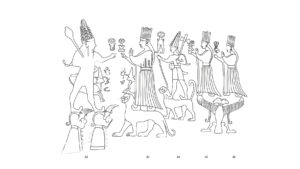
Main panel in Chamber A (Reliefs 42–46) showing the chief deities Teššub and Ḫebat (©
Luwian Studies#1217).
_______________________________

Proposal for the cosmological model depicted in Yazılıkaya, including all reliefs of deities and emphasizing the groups they form and how these are related to each other to symbolize recurring celestial cycles (© Luwian Studies; #1419).
_______________________________
Scientific publication (Open Access)
Zangger, Eberhard, E. C. Krupp, Serkan Demirel and Rita Gautschy (2021): “Celestial Aspects of Hittite Religion, Part 2: Cosmic Symbolism at Yazılıkaya.” Journal of Skyscape Archaeology 7 (1).
_______________________________

What follows is an interview with Professor Frank Korn. Now retired from Seton Hall University’s Classics Department, he has written for a variety of publications and has authored books, such as Hidden Rome, Below Rome, and A Catholic’s Guide to Rome, and more. He has traveled to Rome frequently during his lifetime, both professionally and for leisure.
Q. In Hidden Rome, you wrote about the Ara Pacis, one of the greatest monuments of ancient Rome, missing for centuries, found during the Fascist era. Can you tell us about this?
A. Of all his accomplishments, the emperor Augustus was most proud of bringing peace at last to a land torn by war throughout its then 700 years of existence. This was the start of what future historians would call Pax Romana, an era of peace and stability that would span almost two centuries. And so the Senate soon raised an altar, calling it the Ara Pacis, The Altar of Peace, to honor their esteemed leader.
In his memoirs, Augustus tells us of the monument. This shrine must have fallen victim to one of the many sacks of Rome by the barbarian hordes after the fall of the empire. All traces of it – even its location – was lost throughout the Middle Ages. In 1859, during renovation on a Renaissance edifice – the Palazzo Fiano – workmen discovered numerous slabs of carved marble which many scholars identified as fragments of the Ara Pacis. In 1937, by order of Mussolini, the site was thoroughly excavated bringing to light extensive portions of the peace shrine. These were ultimately reassembled on a platform erected near the Tiber where we can view and admire the monument in our time.
______________________________

The Ara Pacis. teldridge+keldridge, Creative Commons Attribution 2.0 Generic license, Wikimedia Commons
______________________________
Q. The Tomb of Caesar Augustus is massive. Can you tell us about its history and mystery?
A. As far back as a quarter century before the Christian era, Augustus commissioned construction of a massive mausoleum to serve as the final resting place for himself, his family, and his successors. Marcellus, his beloved nephew, was the first to be entombed there. He died of malaria in 23 BCE at the age of 19. Had he lived, he would have been his uncle’s successor. Augustus’ son-in-law and great friend Marcus Agrippa was laid to rest there a decade later.
The historian Strabo gives us this description of the tomb: “A huge rotunda rising on a gigantic square base, both of pure white marble richly decorated and landscaped with cypresses…” The cypress was adopted from the Etruscans as a symbol of mourning. Flanking the entrance were two towering obelisks brought to the imperial capital from Egypt on order of Augustus.
Even in ruins, which we see today in the Campus Martius, the tomb of Augustus is impressive and imposing.
Q. Years ago, I recall staying in a convent hotel across from the Circus Maximus and walking around what’s left of the racing area. You wrote that the Circus Maximus sat 385,000 spectators and that Romans had “Hippomania.” What does that mean and what was this rowdy place?
A. Hippos in ancient Greek means horse; mania means frenzy, enthusiasm, mad passion. “Hippomania” is a neologism for the ancient Romans’ zest for horse racing. In the sixth century before Christ, Tarquinius the King took advantage of the oblong valley between the Palatine and Aventine hills to build a race track for horses. He ordered wooden grandstands to be constructed on the slope of each hill, and a dividing island – also of wood – to be laid out through the center of the valley. The starting gate was placed at the southern end of the 620-meter-long oval race track. Thus was born the prototype for all horse-racing stadia ever since. By the time of Caesar Augustus the arena had been transformed into stone, travertine to be precise. The dividing island, or spina, was made into a showpiece of sculpture and architecture, centered by a lofty obelisk brought from Egypt. The grandstands could by now seat 385,000 roaring spectators.
Under Augustus there were over 300 racing days a year, with a daily card of twelve races. There were four stables or horse farms that sponsored the events. These stables were known as the Reds, the Greens, the Whites, and the Blues, from the colors of the garments worn by their respective riders.
Heavy betting was rampant. There were numerous race courses – called Circuses – in and around the city. This was the main and largest one. Hence the name: Circus Maximus.
______________________________
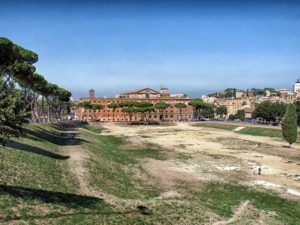
The Circus Maximus as it appears today. Pixabay, Public Domain
______________________________
Q. Even today, the ruins of the Baths of Caracalla are massive. Can you tell us about this “elaborate country club complex”?
A. Each July and August across more than five decades in the last century – until massive budget cuts in the 1990’s – the Rome Opera Company would stage Verdi’s Aida and other spectacular music dramas within the brooding ruins of the third century Baths of Caracalla.
Eighteen centuries earlier the sounds here were much different. The cavernous halls of the tepidarium (warm room), the calidarium (hot room) and the frigidarium (the cold room) rang with the cacophony produced by the whistling, hooting, jeering, laughing, and ribald singing of hundreds of bathers bent on having a good time.
But there was much more to this bathing establishment which served as a kind of ancient country club – a place to meet friends, stroll the landscaped grounds and chat, play ball, work out, get a massage, have drinks, enjoy dice games in the conference rooms, and so forth. Imperial Rome’s jet-set crowd would pull up to the entrance in closed litters. The “have-nots” arrived on foot, believing that any inconvenience or discomfort was well worth while just to escape, for a few hours, the dreariness of inner city tenements. A local ordinance scheduled different times for men and women in order to prevent mixed bathing. Every now and then there were violations of the law, resulting in scandals that became the talk of the town.
_______________________________
_______________________________
Q. You quote Percy and Shelley, who had great joy wandering around the Bath’s ruins. The Romantics loved ruins. Do you and your wife Camille get a special feeling being around ruins? What’s the aesthetic, the message?
A. Camille has been my treasured companion on most of my one hundred and seven trips to Rome across the last fifty two years. Some of these trips were for full semesters, some for a fortnight, some for an in between length. Like Shelley, et. al., we love visiting the relics of “the glory that was Rome”. In the ruins of the Augusteum, the mausoleum of Caesar Augustus, we can’t help but reflect for moments on end that there once rested here the ashes of that restless, gifted man who “found Rome a city of brick and left it a city of marble”. Down in the great Forum, amid the fallen columns and ubiquitous weeds, we never grow blasé about trodding the original paving stones of the Via Sacra that felt so often the sandal-shod feet of the consuls and senators, and the ordinary cives Romani.
Q. Trajan’s column depicts the machinery of war and conquest. What are the particulars about this column? It would scare any potential enemy, wouldn’t it?
A. The Column of Trajan, at one end of the forum named for that much accomplished ruler and city planner, was raised amid great panoply in the year 113. The bands of bas reliefs circling up the full height of the slender monument – 125 feet – represent Trajan’s triumphs over the Dacians beyond the Danube. Tiny windows illuminating the spiral staircase inside are almost concealed among the carved figures of soldiers, weapons, and p.o.w’s.
The column was originally topped with a statue of the emperor, facing the Forum, the Colosseum, the grandeur of Rome. The effigy stood there majestically through the ages until Pope Sixtus V (1585-90) replaced it with a likeness of St. Peter, facing the Vatican in the opposite direction. With the apostle’s back turned on the ancient splendor, Sixtus has Peter declaring: “Roma pagana est mortua. Viva Roma Christiana!”
_______________________________
_______________________________
_______________________________
Q. You wrote that the Romans brought twenty-two obelisks from Egypt and that thirteen are still pointing at the sky. Did the Romans have Egyptomania?
A. While I would not go so far as to call it “Egyptomania,” the Romans seemed to be curious about the culture and custom of the province they called “Aegyptus”, and by the exotic beauty of its women. They, the Romans that is, could relate to the Egyptians also because both peoples were polytheistic and saw religion as a civic duty. Both, at times, deified their rulers. Furthermore, Egypt is mostly in Africa, that mysterious continent, except for the Sinai peninsula which is in Asia.
Pliny the Elder, in the first century of our era, was fond of saying “Ex Africa, semper aliquid novi” – Out of Africa always comes something new – probably alluding to a passage from the writings of Aristotle who was likely referring to the numerous forms of wild life, principally in Libya. Could Pliny, now that it was a Roman province, have also had Egypt in mind? One wonders. Another indicator of Romans being somewhat intrigued by that land and its people is a curious monument in Piazza della Minerva. Here where once stood a temple to that goddess of war, the sculptor/architect Bernini in 1667 placed a statue of an elephant surmounted by an obelisk with a Latin inscription claiming that it would take the strength of that enormous beast to sustain the wisdom of the Egyptians.
Q. Before my first trip to Rome, you recommended Santa Prisca, on of the few house-churches mentioned in the New Testament. Today it’s a small, lovely church on the Aventine Hill, and one of its treasures lies under the church: the Mithra ruins. Can you tell us about all this?
A. Late in his reign, the emperor Claudius ordered the expulsion of all Jews from Rome. Among the exiled multitude was a pious couple, Aquila and his wife Prisca, who sought asylum in Corinth where they crossed paths with the apostle Paul. Under his influence the couple converted to Christianity. When Claudius’ edict was at last rescinded, they returned to their home on the Aventine Hill, and allowed their residence to be used as a place of Christian worship, one of the two dozen or so domus ecclesiae, i.e. house-churches, in the city of Rome.
We know this from a line in Paul’s letter to the Romans (16:3-5) which reads: “Give my greetings to Prisca and Aquila and to the church that meets in their house.” When Constantine ended the persecutions in 313, the Christian community erected a new church building on what was left of the original house and called it the Church of Santa Prisca. (Whenever I am back in Rome, the priests there invite me to do the readings at Mass.)
In 1933, during excavations to find the rooms of the original structure, archaeologists discovered that there had once been a Mithraeam on the site in pre-Christian times.
Q. Also, can you tell us about San Clemente and what’s below?
A. Christian pilgrims to Rome, hoping to be swept back across a million yesterdays to apostolic times ought to make their first stop at the church of San Clemente, just four blocks down on the Via San Giovanni in Laterano from the Colosseum.
San Clemente tangibly peels away the centuries, for it is actually three churches superimposed one upon the other with massive stonework and piles of masonry from three distinct Roman epochs. On this site, Christians have gathered for worship across two millennia.
When Peter was serving as bishop of Rome there dwelt here a pious priest named Clement who allowed his residence to be used as a house-church. In the year 88 Clement was elected to the throne of St. Peter, becoming the fourth pope of the infant church. In the late fourth century the faithful filled in the ground floor of Clement’s home with rubble and mortar to provide a bedrock foundation for the basilica they would soon raise there. The basilica was given the name San Clemente. Throughout the Middle Ages, it remained one of the most prominent of the city’s Christian shrines. In 1084 it fell victim to the Norman sack of Rome.
In 1108 Pope Paschal II constructed a new basilica on the remains of the fourth century structure. Today it is possible to visit all three levels.
As at Santa Prisca’s, a Mithraeum was uncovered here, too. In the center is a block of marble with a relief showing the god Mithras sacrificing a bull.
Q. Can you tell us about this Mithra religion? Also, why did it come to Rome? And can you tell us about the Isis religion in Rome?
A. Before the gospels reached the banks of the Tiber, a middle eastern cult known as Mithraism had taken root in the Capital. This centered about the worship of Mithras, an Indo-Iranian divinity associated with light and the sun. The earliest devotees claimed that since evil spirits ever lie in wait for hapless man, Mithras had come into the world as man’s friend and savior. Unlike the mainline Roman cults, Mithraism preached the immortality of the soul and urged a perpetual quest for personal sanctification, in an ongoing preparation for a spiritual life of bliss in eternity. It also called for new values and a fresh approach to terrestrial existence. Instead of gravitas, the typical grim view of life, there was to be a quiet joy. Mithraists were also expected to practice asceticism, self-control, and a fierce resistance to all impurity and decadence.
Mithraism, at least in the Roman world, found its most ardent followers in the military. Roman legions propagated the cult throughout the empire.
With the spread of Christianity in the late fourth century, the eastern religion of Mithraism began to be suppressed. In 377 the prefect of Rome, Gracchus, delivered the coup de grace with his orders to destroy all mithraea.
Q. Can you tell us about the Quirinal Hill and Esquiline Hill?
A. Il Quirinale, the Quirinal, is one of the original seven hills of Rome, all enclosed by the ancient Servian Wall. It takes its name from a temple to the Sabine god Quirinus which was later adopted as a Roman deity. The temple crowned the summit, where since the fourth century rises the patriarchal Basilica di Santa Maria Maggiore, so called because of all the Eternal City’s nearly seventy churches honoring Mary — this is the major one.
The ancient temple was, in the eighth century BCE, renamed the Temple of Romulus Qujirinus following the apotheosis of Romulus, mythical founder of the city. To this shrine there was assigned a special priest –- the Flamen Quirinalis — among whose duties was to preside over the sacred rites to the divinity each February 17, the feast day called Quirinalia.
In the neighborhood of the temple, in the late Republic and throughout the Imperial era, could be found many fine estates of the Roman elite.
The Esquiline Hill’s etymology has many versions. One I find fairly plausible is “ex colere” (to live outside) suggesting that much of the hill stood outside the circuit of the Servian Wall, at least early on. This hill was an amalgamation of the beautiful and the ugly. In the upper reaches were some fine residential areas lined with trees, especially umbrella pines. Down lower on the slopes was the dreaded Suburra, a slum of great squalor with a high crime rate. The satirist Juvenal wrote that no man should walk in this area of the city after dark without having first made out his will.
Q. You write about the area in Rome called Largo Argentina. Did the Fascists order that area excavated? What did they find?
A. Largo, like the word piazza means a city square. One such place in Rome is called Largo Argentina. Unlike the Eternal City’s celebrated piazzas with their splashing fountains, sidewalk cafes, strolling musicians, and a baroque church or two, Largo Argentina offers only crawling traffic and urban din. One redeeming factor is the Teatro Argentina with its peach facade and this inscription to the appropriate Muses:
ALLE ARTI DI MELPOMENE D’EUTERPE E DI TERPSICORE
But the main attraction of the square is the sunken area in the center, some twenty five feet below the current street level, featuring the special remains of four temples from the early Republic. Discovered as recently as 1930, these shrines are so ancient that archaeologists soon realized that they had been submerged beneath the stratification of Rome so long ago that even Caesar Augustus likely had never seen them. The deities to which these temples were dedicated are as yet unidentified.
When Mussolini learned of this discovery he ordered further extensive digging at once. Thus the classical world owes Il Duce somewhat of a debt of gratitude.
______________________________

Temple A in Largo Argentina. Amphipolis, Creative Commons Attribution-Share Alike 2.0 Generic license, Wikimedia Commons
______________________________
Q. In your writing on Pagan Rome, you included the dinner party, which Petronius wrote about. So, it was a lot of excess food and wine, but also it had a somber theme about the transitoriness of life. Can you tell us about these feasts? Is the evidence all literary or is there some archaeological evidence?
A. In that long ago era of no radio, no television, no I-pads, nor I-pods, an invitation to a dinner party was one of just a few things to look forward to for a Roman evening. And that treat was only for the well-to-do.
In his witty novel, Cena Trimalchionis, the first century writer provides a glimpse of the lavishness of the food and the opulence of the setting at such gatherings. The principal part of the meal followed an hors d’oeuvres hour and was concluded with a session of drinking and levity, which the more dissolute among the guests prolonged until dawn. In the course of the clamorous get-togethers there would customarily be music, singing, dancing, and various parlor games. This was the authentic time for winding down from the stresses and annoyances of the day.
Every host was eager to make a show of his financial status via plush room decorations, expensive dinnerware, and exquisite objets d’art. We learn all this mostly from ancient writings and particularly from archaeology. During the early excavations at Pompeii, in the so-called House of Menander, a stunningly beautiful set of pure silver dinnerware – 118 pieces – was unearthed. In other Pompeiian homes we see paintings depicting formal suppers and an occasional well-preserved triclinium, dining room with a sloping couch ranged on three sides of a square table, the other side open for the servants to bring course after course after course. The paintings and the layout of the room, and the word triclinum show that the Romans did not sit, but rather reclined at the table.
One more little curious note: as the guests arrived they would find at the entrance to the dining room a slave calling out “Pede dextro, quaeso”, Right foot please! An old superstition held that by putting one’s left foot first over the threshold was to jinx the whole evening from the very start.
Q. Can you tell us about some of your favorite arches, gates, aqueducts and anything else you’d like to add?
A. As for triumphal arches in Rome, our favorite is the Arch of Titus which honors his conquest of Jerusalem and provides the ceremonial entrance into the Forum. In a remarkable state of preservation, the arch features many beautifully carved bas reliefs. One shows the triumphal parade with soldiers bearing some of the spoils of victory among which is an enormous Menorah, the seven-stemmed candelabrum taken from the great Jewish temple. What a compelling testimonial to the old maxim: Ars longa, vita brevis. The sculptor, whoever he was, has been dust for two millennia, while his splendid carvings live on.
Still clearly engraved on the tympanum are the words: “Senatus Populusque Romanus. Divo Tito Divi Vespasiani F.” — The Senate and the Roman People to the Divine Titus, Son of the Divine Vespasian. Upon their deaths both emperors – father and son, were deified.
Our favorite gate is the Porta Latina, just inside of which is the fourth century church with the poetic name of: St. John at the Latin Gate.
Of the ancient water-works we prefer the Claudian Aqueduct (4th century BCE) under whose arches our three sons – as little boys – used to play hide and seek with their Roman pals, out in the counrtyside.
_____________________________
_____________________________

Iconic scene of the triumphal march of soldiers carrying the great Menorah captured from Jerusalem, a bas relief carved upon the Arch of Titus. Pixabay
_____________________________
Q. Can you tell us about the most important roads, such as the Via Appia or Appian Way?
A. An old saying claims: “All roads lead to Rome.” Today’s civis Romanus put it this way: “Tutte le strade portano a Roma.” This can be taken not only figuratively but also literally. All the great highways that the gifted Roman road builders constructed lead from a multitude of points in the far reaches of Italy inexorably to the capital.
The oldest of these, the Via Appia, opened to traffic in 312 BCE by the consul Appius Claudiuis, and named for him was the great south road, linking Rome with the Naples area. Terminating in a suburb called Capua, the road proved so convenient it was extended all the way to Brundisium on the Adriatic Coast. The people called it Regina Viarum, the Queen of Roads. Once trafficked by iron-wheeled chariots and horse-drawn delivery wagons, the original paving stones remaining in some stretches are now caressed by the rubber tires of the modern automobile. Other routes in the ancient highway network bear names like: Via Latina, Via Ostiense, Via Salaria, Via Aurelia, Via Cassia, Via Flaminia and so on.
____________________________
____________________________
Q. The catacombs – it’s a fascinating journey on ancient roadway just to reach them. What are they and who’s buried there?
A. The catacombs are those subterranean cemeteries of the early Christians and Jews in Rome. In fact, it was the city’s Jewish colony which first conceived of the idea of tunneling the subsoil outside the walls to provide burial grounds for their loved ones. There were eventually dug – across the first four centuries of our era — some seventy such Christian sites and a much smaller number of Jewish ones.
Because of a law forbidding burial of ashes and bodies within the ancient city fortifications, all of these cemeteries lie beyond them, along the roads leading out of Rome. Three of the largest –- the Catacomb of St. Callistus, that of St. Sebastian, and the one called St. Domitilla — are located along or near Via Appia as are the Jewish cemeteries, both under vineyards, the Vigna Randanini and the Vigna Camarra.
A catacomb (so called from the Greek Kata (down) and Kumbas (in the hollows), is a labyrinth of tunnels – some ten to twelve feet in height and about three feet in width – with niches of varying dimension one above the other, carved out of the walls. In these recesses, called loculi, were placed the bodies, usually wrapped in linen according to an ancient Jewish custom. The loculus would then be sealed with bricks or a slab of marble – depending on the financial status of the bereaved family.
The bricks would soon be covered over with a layer of plaster into which would be etched – or on which would be painted – the name, the age, the date of entombment, perhaps the occupation or some other details of the deceased.
These epitaphs tell us much about life back then about the family bond, about religious beliefs, about the hope of an after-life, about the average life span, about the sad high rate of infant and child mortality, about the invocation of saints – particularly Peter and Paul – and especially of martyrs. Many of the inscriptions are in Greek, for that was the liturgical language of both Christians and Jews in old Rome.
After a burial, the grieving family would often hold a refrigerium (cold meal) in honor of their lost loved one. This was the forerunner of the modern custom of a repast. Some families were affluent enough to afford not merely a niche but a small room (cubiculum) for their burials and often allowed the less fortunate mourners to use the room for their refrigerium.
_____________________________
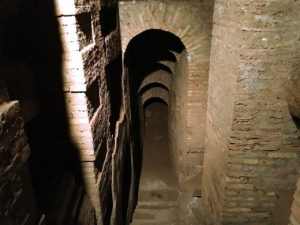
What lies beneath — A view within the ancient Roman catacombs. George Syrios, Pixabay
_____________________________
Q. What movie, in your estimation, depicts Rome’s ruins and grandeur best?
A. Most of the Hollywood productions set in Rome that I have seen feature the usual popular tourist sites, e.g. the Colosseum, the Spanish Steps, Trevi Fountain, Piazza Navona, Villa Borghese, the Via Veneto, et cetera. I don’t recall any showing the Roman Forum, the Circus Maximus, the Baths of Diocletian and those of Caracalla, or the funeral monuments along the Appian Way, or Largo Argentina, etc.
While I have not seen the much acclaimed film, “The Gladiator,” I am told that it does an excellent job of showing the grandeur that once was Rome.
Q. What is a must-read essay or book from ancient Rome that has a profound message for those who love history and archaeology?
A. Of these there are several that I can enthusiastically recommend, such as the satires of Juvenal, the Annuales by Tacitus, the Commentaries on the Gallic Wars by Julius Caesar, among numerous others.
For a glimpse of the political and social goings-on of the late Republic, I eagerly suggest the six volumes of Cicero’s correspondence with the movers and shakers of the day and with his alter-ego, Atticus. For an eyeful of family life, leisure interests, luxurious country villas, attachment to one’s home town, etc., the letters of Pliny the Younger make delightful reading, as does his eye-witness epistolary account of the burial of the decadent city of Pompeii by the eruption of Vesuvius. I’ve always found it fun to study history by opening someone else’s mail.
As for the importance of studying history I would refer you to Cicero’s quote: “He who does not know what took place before he was born, remains forever a child.”
As for the value of archaeology, of laboriously digging up the past, I like what one archaeologist told me: “I dig to find out who I am”.
Cover Image, Top Left: The Roman Forum. StevoLeBlanc, Pixabay
____________________________
About Frank Horn
Frank is retired from Seton Hall University where he was an Assistant Professor of Classical Studies. He is the author of nine books, such as Hidden Rome and A Catholic’s Guide to Rome. He was a Fulbright Scholar at the American Academy in Rome, and he won the Princeton Prize for Distinguished Teaching.
Richard and his family happened to meet Frank (the interviewer) and Camille Korn at Pinho’s Bakery in Roselle, NJ. They soon realized the connections they had going back two generations. When she attended Benedictine Academy, Bonnie Marranca (Richard’s sister) wrote Frank a fan letter having to do with Rome and the study of Latin. Frank had written articles in local papers that informed and inspired countless readers.
Frank and Camille have been to Italy about sixty times and have also taken groups there. Frank’s conversation and writing, based on his travels and his life-long study of the classics, capture the magic and beauty of Rome.
About the interviewer
Richard recently conducted interviews of Egyptologists Salima Ikram and Kara Cooney, published in Popular Archaeology. In the last year, he has authored stories published in Coneflower Café and The Raven’s Perch; poetry in The Paterson Literary Review; and his book, Speaking of the Dead, has recently been accepted for publication by Blydyn Square Books in NJ.
He has taught English and the humanities for over a quarter-century, culminating in a Fulbright to teach at LMU in Munich. He also has been awarded six NEH summer seminars. He and his wife Renah and child Hera also make travel and educational videos under the heading Childe Hera’s World. Their hobbies are yoga, hiking and travel. _______________________________
Advertisement
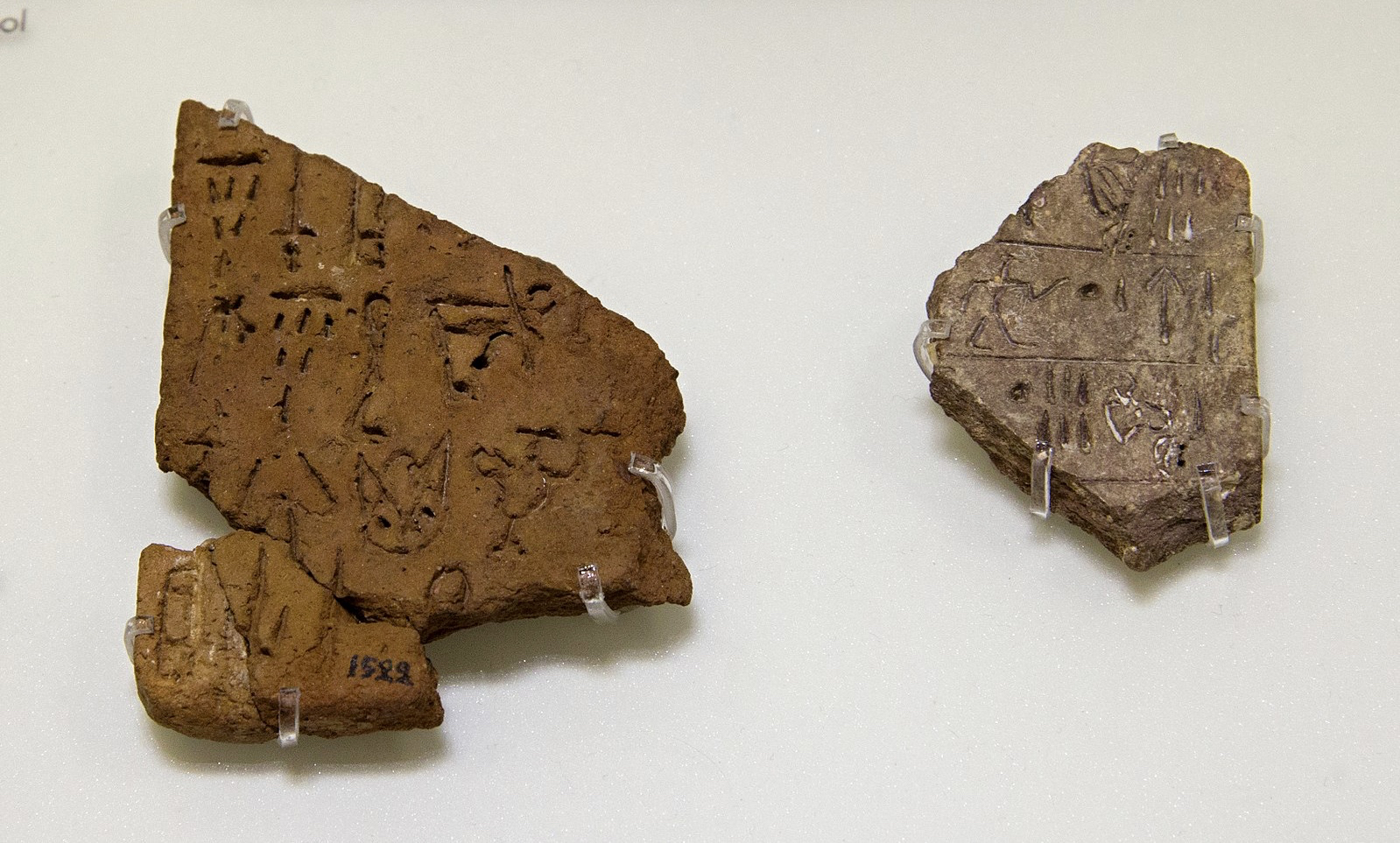
It may be time to start thinking of TWO as actually ONE.
Since their discovery, scholars have split the best-known early ancient Aegean scripts into two separate and well-attested writing systems — Linear A and Linear B. First discovered by British archaeologist Sir Arthur Evans while excavating the ancient Minoan city of Knossos on Crete at the turn of the century (1900), these scripts were manifested mostly on clay tablets and seals that survived the ages, thought by scholars to be due to baking from accidental fires. Between 1951 and 1953, Michael Ventris and John Chadwick successfully deciphered the ancient Linear B script. While Linear A was found primarily at ancient palace sites on Crete, Linear B was found mostly within palace archives at the excavated sites of Knossos, Cydonia, Pylos, Thebes and Mycenae. Linear B is considered the earliest form of Greek script. Linear A, which preceded Linear B, remains undeciphered, used mostly by the Minoans, whose language is still unknown, to document transactions as part of the administration of their palace business.
Though the respective scripts are still conventionally thought to be separate, to this day scholars continue to debate the nature of the relationship between the two and their origins, the scripts exhibiting clear similarities in both structure and paleography.
Academic Tour De Force
Enter here Dr. Ester Salgarella, who embarked on an exhaustive, in-depth study of Linear A as the basis and focus of her doctoral dissertation while pursuing her PhD at St. John’s College, University of Cambridge.
“There are no classes on LA [Linear A] at the University, so only at the graduate level could I work freely on what I liked most,” wrote Salgarella in her recently published interview with Popular Archaeology Magazine*. “I had always been intrigued by the partial knowledge we had of the LA to Linear B transmission process, and it puzzled me. When I proposed this topic for my PhD to my supervisor, I must say I was expecting a rejection. When the ‘yes’ came, I was beyond delighted! This meant I had to acquire knowledge of LA by myself, and full days, weeks and months were dedicated to that single purpose, thanks to the magnificent holdings of the Cambridge University Libraries and the ‘Mycenaean Epigraphy Room’ private collection in the Faculty of Classics.”
The result of her efforts has been nothing less than remarkable, leading in part not only to the awarding of her PhD but also the post-doctoral publication of her related book, Aegean Linear Script(s): Rethinking the Relationship between Linear A and Linear B, published by Cambridge University Press. Her efforts also led to her creation and ongoing development of a unique, searchable and free paleographical database for Linear A known as SigLA, in collaboration with computer scientist Dr Simon Castellan at INRIA, University of Rennes (France).
The book itself may stand among the world’s best academic works on the subject, arguably inducting Salgarella onto the short-list of the world’s experts on Linear A. In 380 pages parsed among 5 intricately detailed and graphically rich sections, Salgarella takes the reader on an in-depth passage to a deeper understanding of the elusive script and how it relates to the later Linear B script. “I set off to examine the peculiarities of the transmission process to assess the degree of relatedness,” between Linear A and Linear B, comments Salgarella about the purpose of her book.* She achieves her objective while acknowledging at the same time that, as is common in all academic pursuits, the content is subject to healthy debate.
Setting the stage to help the reader understand where she is going with her narrative, Salgarella reviews in detail the current state of knowledge about the script, including an analysis of the evidence, structure and paleography of both Linear A and Linear B. With this foundation, she then introduces and expounds upon the interpretive models she formulates as her method of analyzing the respective structural and paleographical characteristics of the script systems.
Not a Replacement, But a Continuum
Most significantly, Salgarella’s research and analysis as detailed in her book points, in her view, to some game-changing conclusions about fundamentally rethinking our understanding of the two scripts. For the reader, these takeaways are spelled out in the final section of her book:
First and foremost, she argues that the long understood ‘replacement’ of Linear A with Linear B did not actually occur as traditionally reflected in the literature. “The joint result of the combined structural and paleographical analysis reveals that the two scripts (as well as systems) appear closer than previously assumed on both structural and graphic grounds,” Salgarella stated in a recent interview with Popular Archaeology. “The script is continued in its graphic form with only slight modifications; the system itself was continued.”* In other words, the transmission process between Linear A and Linear B was more fluid than conventionally described. Indeed, as she argues in the conclusive remarks in her book, Linear A and Linear B should actually be thought of as one script, not two. Additionally, Salgarella argues, “my paleographical analysis suggests that LB was ‘created’ under the graphic influences of LA writing practices in use at North and North-East coastal sites,”* where contact and influence from mainland Greece was likely most acute.
Finally, for the historian and those familiar with the literature touching on the Mycenaean ‘conquest’ of Crete during the Late Bronze Age, Salgarella suggests an important implication from her research that may likely draw further debate: that this ancient island civilization never really saw such a clear violent takeover. “These results may make us rethink our very interpretation of the so-called ‘Mycenaean takeover of Crete’ still found in the literature,” she stated in the recent interview. “There was indeed language change in the transition between LA and LB, and their respective administrative systems, but this is not enough to claim a ‘takeover’ of the island.”* It is clear that a Greek-speaking group/community at some point controlled the highest levels of administration, however this does not necessarily mean there was an ‘invasion’.”
So did the Mycenaeans, as we understand them from ancient mainland Greece, really overtake the island society on Crete as conventionally thought? The debate goes on, but the script, according to Salgarella, does not clearly support that scenario.
An Educational Journey
It should be noted that Aegean Linear Script(s) is not easy grist for those of us who are uninitiated in the fields of linguistics, paleography, ancient scripts, and the study of Linear A and Linear B in particular. For this reason, for the general reader, it might be advisable to keep a dictionary close at hand while fathoming the terminology in the text. It is nonetheless, in this writer’s opinion, a work of unquestionable and exceptional academic prowess. If the reader can exercise sufficient self-discipline to find oneself arriving at the final section detailing the author’s overall conclusions, it is a richly eye-opening educational experience, and a must-read for those interested in acquiring a much deeper understanding of Aegean linear scripts.
Cover Image, Top Left: Minoan inscriptions in Linear A script. Phaistos, 1850-1450 BC. Archaeological Museum of Heraklion. Zde, Creative Commons Attribution ShareAlike 4.0 International license. Wikimedia Commons
________________________________
 Aegean Linear Script(s): Rethinking the Relationship between Linear A and Linear B, can be purchased from Cambridge University Press.
Aegean Linear Script(s): Rethinking the Relationship between Linear A and Linear B, can be purchased from Cambridge University Press.
______________________________
*Deciphering the Minoans, Popular Archaeology, April 15, 2021
______________________________
Advertisement
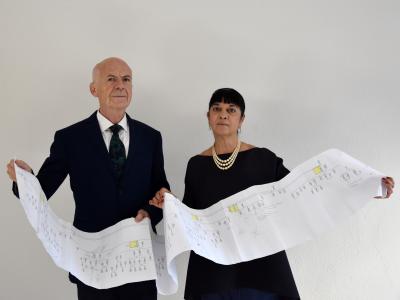
HUMAN EVOLUTION—The surprising results of a decade-long investigation by Alessandro Vezzosi and Agnese Sabato provide a strong basis for advancing a project researching Leonardo da Vinci’s DNA.
Their extensive study, published by the journal “Human Evolution” (Pontecorboli Editore, Florence), documents with new certainty the continuous male line, from father to son, of the Da Vinci family (later Vinci), from progenitor Michele (born 1331) to grandson Leonardo (6th generation, born 1452) through to today—21 generations in all, including five family branches—and identifies 14 living descendants.
The work fills gaps and corrects errors in previous genealogical research into Leonardo’s family, while offering new discoveries and family tree updates.
This text deepens and enormously expands the discovery announced in Vinci, Italy, in 2016 by the same Vezzosi and Sabato of numerous living but indirect descendants including only two males in direct line, up to the 19th generation, from a single branch of the Vinci family.
It also provides for the first time the documentary data and information sources over seven centuries to the present day registry office, with work on additional family branches ongoing.
Leonardo himself had at least 22 half-brothers but no children; a new unpublished document shows that “Paolo di Leonardo da Vinci da Firenze” was a case of homonymy. The five family branches are traced from Leonardo’s father, ser Piero (5th generation), and half-brother Domenico (6th). Since the 15th generation, data have been collected on over 225 individuals. The study, with the collaboration of the living descendants, contributes to the work of the Leonardo Da Vinci Heritage Association.
This extraordinary, authoritative 690-year genealogical investigation is fundamental to affiliated scientific work Vezzosi and Sabato have underway with the international Leonardo da Vinci DNA project, supported by The Richard Lounsbery Foundation. The project involves the J. Craig Venter Institute of La Jolla, California and several other high-profile universities and research centers, including the Department of Biology of the University of Florence, directed by David Caramelli.
The Y chromosome, passed on to male descendants, is known to remain almost unchanged through 25 generations. Comparing the Y chromosome of today’s male relatives with that of their ancestors in ancient and modern burial sites would both verify the uninterrupted family line and certify Leonardo’s own Y chromosome marker.
Questions potentially probed once Leonardo’s DNA is confirmed include reasons behind his genius, information on his parents’ geographical origins, his physical prowess, premature aging, left-handedness, diet, health and any hereditary diseases, and his extraordinary vision, synaesthesia and other sensory perceptions.
Comparison of biological data could also potentially help verify the authenticity of artwork and materials handled by Leonardo, thereby pioneering links between biology and art with broad implications for the world’s art market in terms of artistic attribution and materials.
____________________________
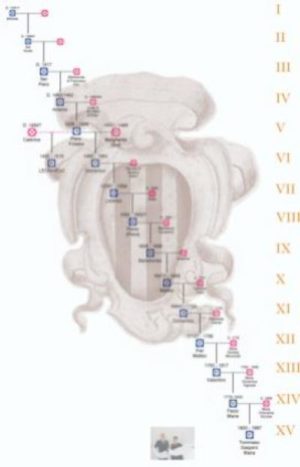
Researchers Alessandro Vezzosi and Agnese Sabato have documented 21 generations of Leonardo Da Vinci’s family covering 690 years and identified 14 living male family descendants. Alessandro Vezzosi and Agnese Sabato
____________________________
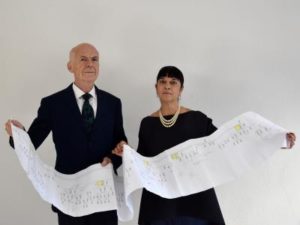
Researchers Alessandro Vezzosi and Agnese Sabato. Alessandro Vezzosi and Agnese Sabato
____________________________
Article Source: HUMAN EVOLUTION news release.
____________________________
About the authors
Alessandro Vezzosi
Leonardist and art historian. He is originally from Vinci, where he founded the Leonardo Da Vinci Ideal Museum in 1993, with the Archives of fingerprints and Leonardisms, and with the project for “Leonardo’s Garden”. He is the author and curator of countless exhibitions, publications, conferences and lectures on Leonardo, as well as on Michelangelo and Raphael, the Garden of Pratolino, “and places of memory, contemporary art and design, from the United States to Japan.
His books have been translated into 19 languages ??(from Leonardo da Vinci: The Mind of the Renaissance, New York, Harry N. Abrams, 1997 to Leonardo Da Vinci: The Complete Paintings in Detail, New York, Prestel, 2019).
He began in 1973 the research on the locations and spaces and descendants of Leonardo, for what has been configured since 2000 as a search for Leonardo’s DNA. museoideale@gmail.com
Agnese Sabato
Agnese Chairs the Leonardo Da Vinci Heritage Association. She graduated in Modern History from the University of Florence. She collaborates in the organization of exhibitions, conferences, educational activities and institutional initiatives of the Leonardo Da Vinci Ideal Museum (including the “Fingerprint Archive”), and in books and study notebooks. She has published contributions on the history of slaves in Florence and on the myth and image of Leonardo. She has been working since 1993 researching the genealogy and living descendants of the Da Vinci, in collaborations with the Leonardo Da Vinci DNA Project since 2015. leonardodavinciheritage@gmail.com
Leonardo Da Vinci Heritage Association
The Association aims to protect and enhanceLeonardo’s cultural heritage and the spaces and locations related to his life and work. Born as an idea in 2017, the non-profit (Third Sector) Leonardo Da Vinci Heritage Association was established formally in January 2019 to spread in Italy and abroad the knowledge of Leonardo’s life – through research, publishing and exhibition activities; strengthen research, dissemination, documentation and information activities on his life story, with particular reference to the genealogy of his family; safeguard the privacy of his descendants; to promote studies, research and scientific examinations relating to the DNA of Leonardo and his relatives; safeguard his moral and ethical heritage, while respecting and protecting his cultural heritage.
The project is curating creation of the “GeniaDaVinci” database, which will collect the thousands of documents collected for this study and the family tree in progress, to make them accessible to scholars and the general public.
A volume of the new paper in Italian will be published soon with full iconography.
Leonardo Da Vinci DNA Project
Founded by anthropologists Brunetto Chiarelli and Henry de Lumley in 2014, goals of the project include obtaining and sequencing DNA of Leonardo to understand better his extraordinary talents, notably his visual acuity, through genetic associations. Three-dimensional images of Leonardo could possibly be created if sufficient genome sequence data becomes available.
Completed pilot studies confirm the ability to identify useful biological material from centuries old works of art and other kinds of relics and samples. The project also investigates the microbial flora located on and within artworks. Using 16S sequencing, the project has demonstrated a novel finding that there are differing bacterial communities when comparing artwork on wood and canvas, and microbes on stone/marble/plaster sculptures. It has also demonstrated that there are specific genera known for having oxidative positive strains present on paintings on wood and paintings on canvas that could potentially be responsible for deterioration and fading. More generally the Project seeks to stimulate fruitful interactions between, on the one hand, geneticists, molecular biologists, and microbiologists, and, on the other hand, historians, art historians, artists, and other experts in cultural heritage.
Funding for this project is provided by The Richard Lounsbery Foundation. Related news release: here.
Human Evolution
Angelo Pontecorboli Editore – Firenze
ISSN 0393-9375 — ISSN ONLINE 1824-310X
A scientific journal founded in 1969 by Prof. Brunetto Chiarelli, University of Florence.
Managing Editor: Angelo Pontecorboli.
Human Evolution publishes scientific articles on the physical, sociological and cultural evolution of Humankind.
There are numerous disciplines involved in the study of human evolution which the magazine tries to address. Particular attention is paid to molecular evolution, genetics and DNA.
Human Evolution is published in English in Florence, Italy in one volume per year divided into four issues. http://www.
_____________________________
Advertisement
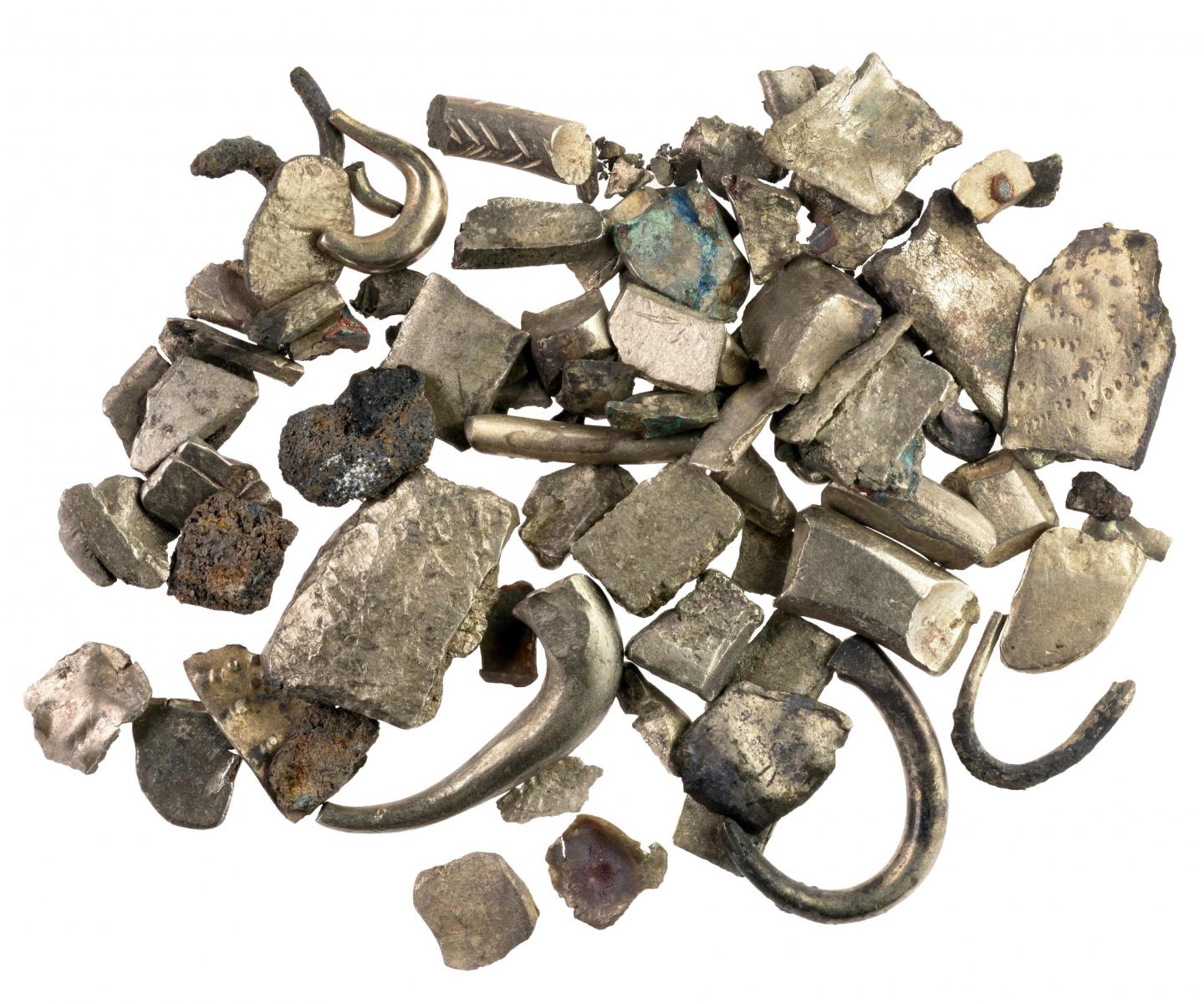
GOLDSCHMIDT CONFERENCE—Scientists have reconstructed the Eastern Mediterranean silver trade, over a period including the traditional dates of the Trojan War, the founding of Rome, and the destruction of Solomon’s Temple in Jerusalem. The team of French, Israeli and Australian scientists and numismatists found geochemical evidence for pre-coinage silver trade continuing throughout the Mediterranean during the Late Bronze and Iron Age periods, with the supply slowing only occasionally. Silver was sourced from the whole north-eastern Mediterranean, and as far away as the Iberian Peninsula.
The team used high-precision isotopic analysis to identify the ore sources of minute lead traces found in silver Hacksilber. Hacksilber is irregularly cut silver bullion including broken pieces of silver ingots and jewelry that served as means of payment in the southern Levant from the beginning of the second millennium until the fourth century BCE. Used in local and international transactions, its value was determined by weighing it on scales against standardized weights. It has been discovered in archaeological excavations in the region usually stored inside ceramic containers and it had to be imported as there was no silver to be mined in the Levant.
Presenting the research at the Goldschmidt geochemistry conference, Dr. Liesel Gentelli said “Even before coinage there was international trade, and Hacksilber was one of the commodities being exchanged for goods”.
The team analyzed Hacksilber from 13 different sites dating from 1300 BCE to 586 BCE in the southern Levant, modern-day Israel and the Palestinian Authority. The samples included finds from ‘En Gedi, Ekron, and Megiddo (also known as Armageddon). They matched their findings with ore samples, and have shown that most of the Hacksilber came from the Southern Aegean and Balkans (Macedonia, Thrace and Illyria). Some was also found to come from as far away as Sardinia and Spain.
Lead researcher Liesel Gentelli (École normale supérieure de Lyon, France) said:
“Previous researchers believed that silver trade had come to an end following the societal collapse at the end of the Late Bronze Age, but our research shows that exchanges between especially the southern Levant and the Aegean world never came to a stop. People around the Eastern Mediterranean remained connected. It’s likely that the silver flowed to the Levant as a result of trade or plunder.
We do see periods of silver scarcity around the time of the Bronze to Iron Age transition, around 1300-1100 BCE. Some hoards from this period show the silver displaying unusually high copper content, which would have been added to make up for the lack of silver.
We can’t match our findings on the silver trade to specific historical events, but our analysis shows the importance of Hacksilber trade from before the Trojan War, which some scholars date to the early 12th century BCE, through the founding of Rome in 753 BCE, and up to the end of the Iron Age in 586 BCE, marked by Nebuchadnezzar’s destruction of Solomon’s Temple in Jerusalem. After that, we see the gradual introduction of coinage, first as finds of several archaic coins and later a transition to a monetary economy in the southern Levant circa 450 BCE which made the trade of Hacksilber less relevant. However, this work reveals the ongoing and crucial economic role that Hacksilber played in the Bronze and Iron Ages economies”.
Commenting, Dr Matthew Ponting, Senior Lecturer in Archaeological Materials at the University of Liverpool said:
“This is important new work that confirms our understanding of trade and exchange routes in the Early Iron Age Levant. The fact that all silver found in the region would have had to have been imported presents exciting possibilities to investigate trade routes more generally as well as to learn more about alloy use and preference during this important period of history”.
______________________________
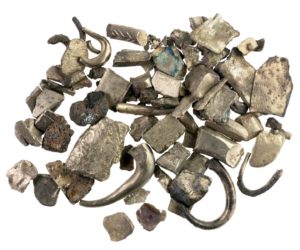
A Hacksilber hoard dated to the middle of the eleventh century BCE found by the Leon Levy Expedition to Ashkelon. We are grateful to L. E. Stager and D. Master, directors of the Leon Levy Expedition to Ashkelon, and to D. T. Ariel, for allowing us to publish these photographs. Photo © The Israel Museum, by Haim Gitler and © Israel Antiquities Authority, by Clara Amit
______________________________
Article Source: GOLDSCHMIDT CONFERENCE news release
Dr Ponting was not involved in this work, this is an independent comment.
The Goldschmidt Conference is the World’s main geochemistry conference. It is hosted alternately by the European Association of Geochemistry (Europe) and the Geochemical Society (USA). The 2021 conference (virtual) takes place from 4-9 July, https:/
______________________________
Advertisement
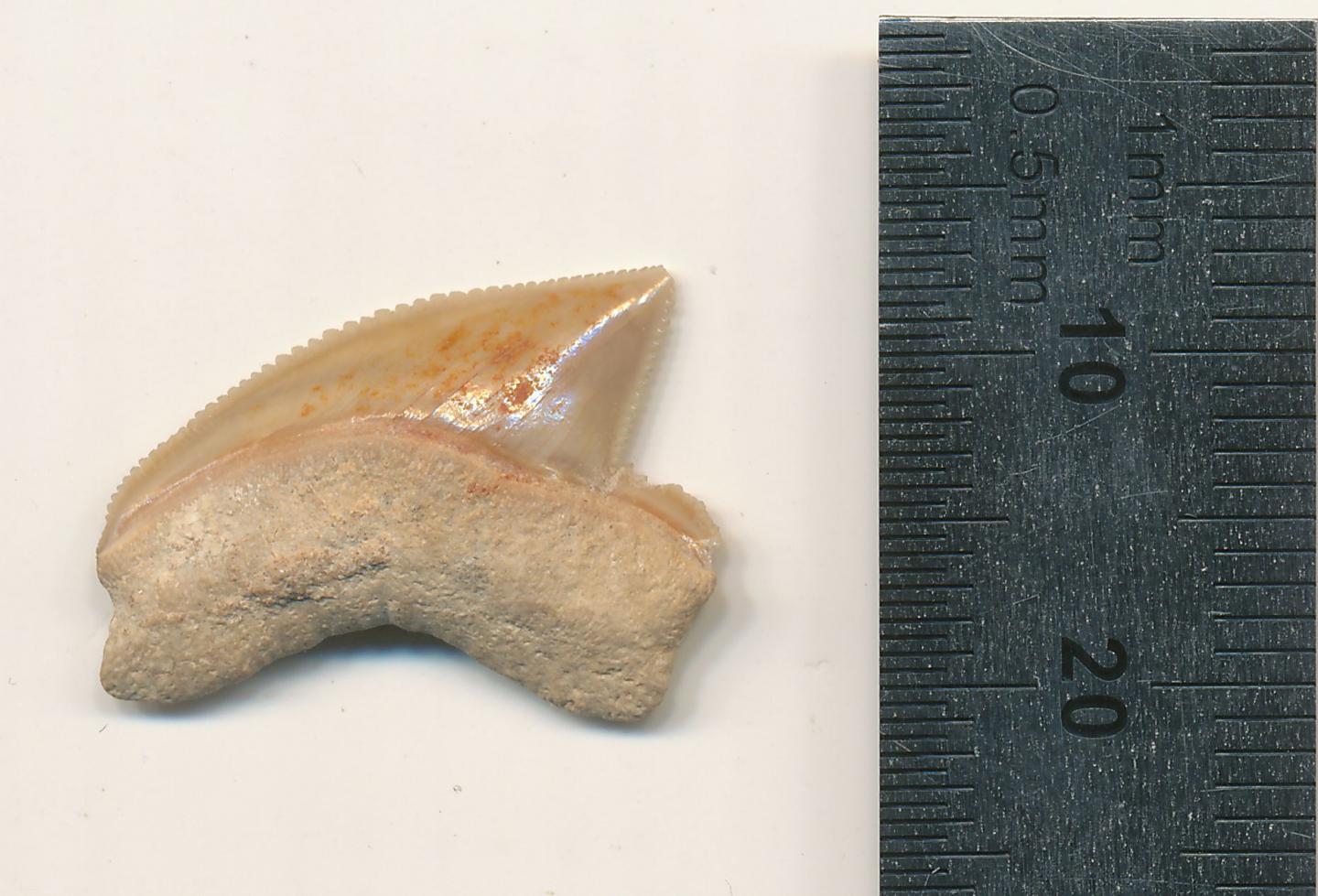
GOLDSCHMIDT CONFERENCE—Scientists have found an unexplained cache of fossilised shark teeth in an area where there should be none – in a 2900 year old site in the City of David in Jerusalem. This is at least 80 km from where these fossils would be expected to be found. There is no conclusive proof of why the cache was assembled, but it may be that the 80 million-year-old teeth were part of a collection, dating from just after the death of King Solomon*. The same team has now unearthed similar unexplained finds in other parts of ancient Judea.
Presenting the work at the Goldschmidt Conference, lead researcher, Dr. Thomas Tuetken (University of Mainz, Institute of Geosciences) said:
“These fossils are not in their original setting, so they have been moved. They were probably valuable to someone; we just don’t know why, or why similar items have been found in more than one place in Israel”.
The teeth were found buried in material used to fill in a basement before conversion to a large Iron-Age house. The house itself was situated in the City of David, one of the oldest parts of Jerusalem, found nowadays in the largely Palestinian village of Silwan. They were found together with fish bones thrown away as food waste 2900 years ago, and other infill material such as pottery. Intriguingly, they were found together with hundreds of bullae – items used to seal confidential letters and packages – implying a possible connection with the administrative or governing class at some point. Normally archaeological material is dated according to the circumstances where it is found, and so at first it was assumed that the teeth were contemporary with the rest of the find. Dr. Tuetken said:
“We had at first assumed that the shark teeth were remains of the food dumped nearly 3000 years ago, but when we submitted a paper for publication, one of the reviewers pointed out that the one of the teeth could only have come from a Late Cretaceous shark that had been extinct for at least 66 million years. That sent us back to the samples, where measuring organic matter, elemental composition, and the crystallinity of the teeth confirmed that indeed all shark teeth were fossils. Their strontium isotope composition indicates an age of about 80 million years. This confirmed that all 29 shark teeth found in the City of David were Late Cretaceous fossils – contemporary with dinosaurs. More than that, they were not simply weathered out of the bedrock beneath the site, but were probably transported from afar, possibly from the Negev, at least 80 km away, where similar fossils are found”.
Since the first finds, the team have found other shark teeth fossils elsewhere in Israel, at the Maresha and Miqne sites. These teeth are also likely to have been unearthed and moved from their original sites.
Dr. Tuetken said:
“Our working hypothesis is that the teeth were brought together by collectors, but we don’t have anything to confirm that. There are no wear marks which might show that they were used as tools, and no drill holes to indicate that they may have been jewelry. We know that there is a market for shark’s teeth even today, so it may be that there was an Iron Age trend for collecting such items. This was a period of riches in the Judean Court. However, it’s too easy to put 2 and 2 together to make 5. We’ll probably never really be sure”.
The shark teeth which have been identified come from several species, including from the extinct Late Cretaceous group Squalicorax. Squalicorax, which grew to between 2 and 5 meters long, lived only during the Late Cretaceous period (which was the same period as the late dinosaurs), so acts as a reference point in dating these fossils.
Commenting, Dr. Brooke Crowley (University of Cincinnati) said:
“This research by Dr. Tuetken and colleagues is an excellent example of why it is so important to approach a research question with as few assumptions as possible, and how sometimes we have to revisit our initial assumptions. It also highlights how beneficial it can be to apply multiple tools to answer a research question. In this case, the authors used both strontium and oxygen isotopes, as well as x-ray diffraction and trace element analysis to establish most likely age and origin of the fossil teeth. It was a monumental of work but these efforts have revealed a much more interesting story about the people who lived in this region in the past. I am very excited by this work and hope that one day, we might be able to unravel the mystery of why these fossil teeth are being recovered from cultural deposits”.
_______________________________
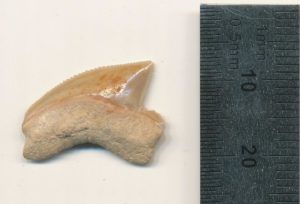
Fossilized Squalicorax tooth Nr. #07815 from the Jerusalem site. Omri Lernau
_______________________________
Article Source: GOLDSCHMIDT CONFERENCE news release
Dr. Crowley was not involved in this work. The work relating to the Jerusalem finds has been published in the peer-reviewed journal Frontiers in Ecology and Evolution 8:570032 (https:/
_______________________________
Advertisement
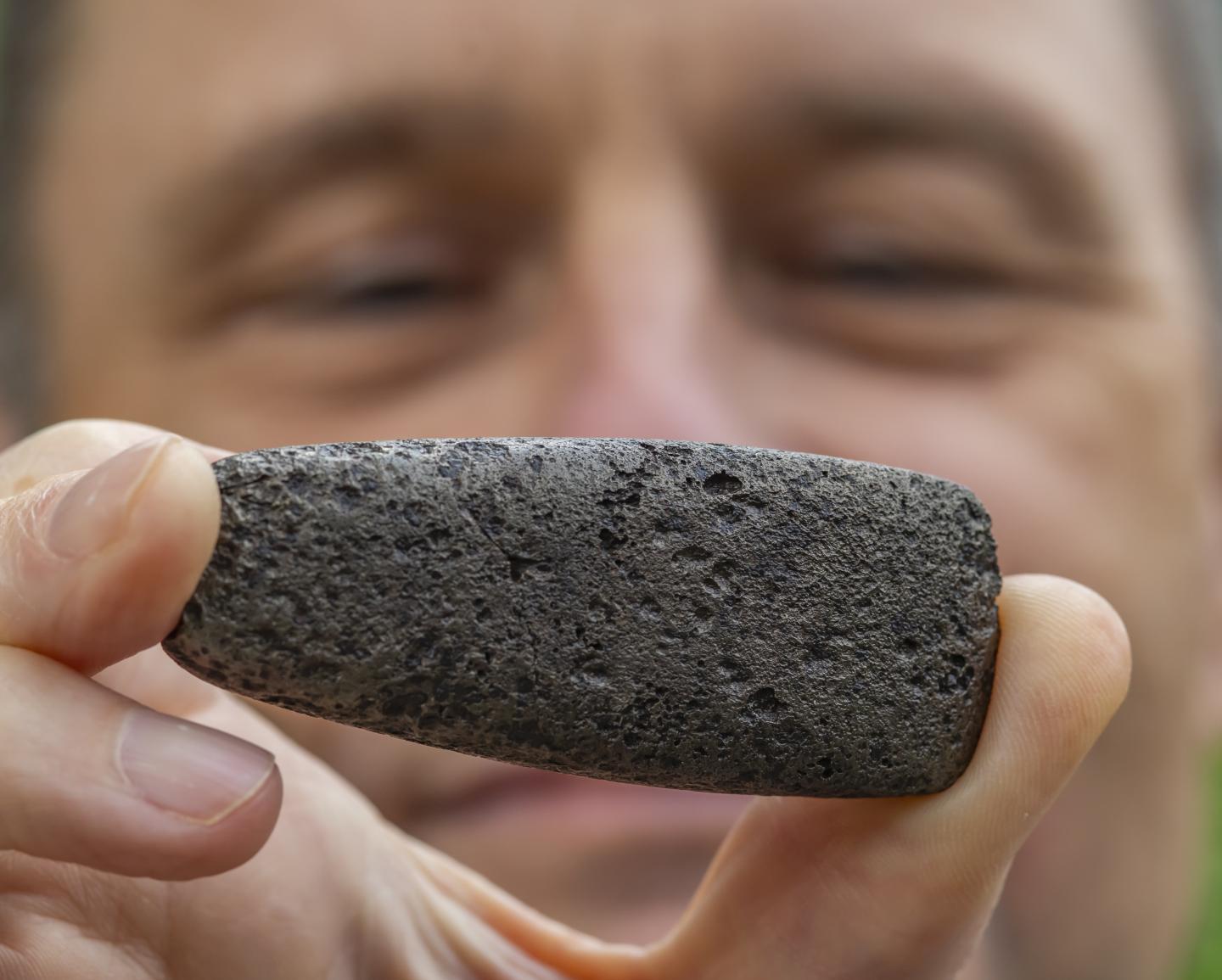
FLORIDA MUSEUM OF NATURAL HISTORY, GAINESVILLE, Fla.—Archaeologists have unearthed a rare trove of more than 80 metal objects in Mississippi thought to be from Hernando de Soto’s 16th-century expedition through the Southeast. Many of the objects were repurposed by the resident Chickasaws as household tools and ornaments, an unusual practice at a time when European goods in North America were few and often reserved for leaders.
The researchers believe Spaniards left the objects behind while fleeing a Chickasaw attack that followed frayed relations between the two groups in 1541. The victors took advantage of the windfall of spoils – axe heads, blades, nails and other items made of iron, lead and copper alloy – modifying many of them to suit local uses and tastes. Chickasaw craftspeople turned pieces of Spanish horseshoes into scrapers, barrel bands into cutting tools and bits of copper into jingling pendants.
The sheer abundance of objects from the site, an area of northeastern Mississippi known as Stark Farms, is one of the factors that makes the find unique, said Charles Cobb, the study’s lead author and Florida Museum of Natural History Lockwood Chair in Historical Archaeology.
“Typically, we might find a handful of European objects in connection with a high-status person or some other special context,” Cobb said. “But this must have been more of an open season – a pulse of goods that became widely available for a short period of time.”
If the researchers’ diagnosis is correct, Stark Farms is only the second place to yield convincing archaeological evidence of direct contact with de Soto’s expedition, after the historic site of the Apalachee capital of Anhaica in present-day Tallahassee, Cobb said.
‘Unconquered and unconquerable’
By the time de Soto arrived in Mississippi in 1540, the conquistador had trekked through the Southeast for more than a year with about 600 people, hundreds of horses and pigs and heavy equipment in tow. A shrewd man with a reputation for bloodshed, de Soto was previously a key figure in the Spanish destruction of the Inca Empire in South America and came to Florida with an eye to further increase his wealth. Finding little gold, he pressed deeper into the interior, alternately befriending and warring with the Native Americans he encountered.
The Spaniards began on a friendly, if aloof, footing with the Chickasaws, whose leader, known as Chikasha Minko, gave them a modest village in which to spend the winter. But tensions rose as the months dragged on: De Soto executed two Chickasaws and cut off the hands of another accused of stealing pigs. The Chickasaws, who farmed maize in the region’s rich prairie soil, also must have grown tired of providing food and shelter for such a large encampment of uninvited guests, Cobb said.
With spring drawing near, de Soto demanded that Chikasha Minko provide him with hundreds of Chickasaws to carry the Spaniards’ equipment to their next destination. According to Spanish accounts of the expedition, the conversation did not go well.
Shortly afterwards, the Chickasaws launched a surprise attack under the cover of night, torching the Spanish camp and killing at least a dozen men, as well as many horses and pigs. The retreating Spaniards set up another camp about a mile away, where they were assaulted a second time. Better prepared, they fought back, but soon picked up and headed north, having lost much of their livestock, clothing and goods.
Meanwhile, the Chickasaws collected from the battlefield dozens of prized metal objects, usually reserved by the Europeans for strategic trades or as gifts to smooth relationships with local leaders.
“It’s kind of like inflation,” Cobb said. “You don’t want too much stuff to get out or that gift will be devalued. That’s what makes this site unusual.”
After the Chickasaws sent the Spanish packing, the region remained largely free of European presence for nearly 150 years.
“This research shows how Chickasaws adapted to invasion by alien intruders and secured their reputation as unconquered and unconquerable,” said study co-author Brad Lieb, director of Chickasaw archaeology for the Chickasaw Nation’s Heritage Preservation Division. “The findings are remarkable in their success in addressing a baseline event in Chickasaw cultural history – the first encounter with Hernando de Soto and the Spanish invaders.”
History confirmed by metal detectors
When Cobb, Lieb and their colleagues first arrived at Stark Farms in 2015, they weren’t just looking for traces of de Soto. The Chickasaw Nation, removed from its traditional homeland to Oklahoma by the U.S. Department of War in 1837, had commissioned the team to identify and preserve ancestral sites and provide Chickasaw university students the opportunity to reconnect with their heritage through an archaeology fieldwork program.
The team focused on studying the environmental factors in the movements of Native Americans across the landscape, where radiocarbon dates showed people had lived since the 14th or 15th century. Curious about early residents’ potential interactions with outsiders, the researchers brought metal detectors, a speedy way of finding objects of European origin. The first day they deployed the detectors, the machines began pinging. Soon, the team was uncovering dozens of items, including a small cannon ball, a mouth harp and what could be a Spanish bridle bit, emblazoned with a golden cross.
“We couldn’t believe it,” Cobb said. “There was a lot of serendipity for sure.”
The style and type of objects, as well as their location, aligned with Spanish accounts of the de Soto expedition and the 1541 battle at Chikasha, the main Chickasaw town. But the researchers found no evidence of a burned village or the remains of horses and pigs. Cobb said the site was likely a village near Chikasha, whose inhabitants visited the site of the conflict and brought items back to their households. They may also have acquired some of the objects during the previous winter through under-the-table trading with Spanish soldiers.
The Chickasaws generally relied on bone, cane or stone as raw materials for their cutting and scraping tools, making the haul of metal a particular boon. While some of the objects retain their original form, the Chickasaws painstakingly reworked others into more familiar shapes. They bent metal back and forth until it broke and ground down and smoothed edges, modifying tools to mimic the design of their traditional Chickasaw counterparts.
“One of the most stunning things we’ve found is an exact iron replica of a Native American stone celt, or axe head,” Cobb said. “I’ve never seen anything like this in the Southeast before.”
Among the more sobering finds were chain links, pulled apart with sharpened edges. “The Spanish brought reams of chain with them to shackle Native Americans as captives and porters,” Cobb said. “This is evidence of some of the first examples of European enslavement of people in what is now the U.S.”
The refashioned items from Stark Farms represent a stage of Native American experimentation and improvisation with foreign items that largely faded by the late 1700s and 1800s, as they folded European materials and technology more completely into their own.
“In the 1500s, a thimble might be turned into a bangle. By the late 1700s, a thimble is a thimble,” Cobb said. “You tend to see a more regular adoption of goods over time.”
Spanish survivors did their own repurposing
De Soto failed to establish any permanent settlements in the Southeast, joining a line of ill-fated expeditions that demonstrated the precariousness of Europeans’ early attempts to dominate the region. He succumbed to a fever on the banks of the Mississippi River in 1542, and his remaining band of men made rafts and floated south to Mexico where they found passage back to Spain.
There, they undertook a repurposing effort of their own: Having failed to find fame and fortune in the Americas, they sold their stories, many of which became bestselling books, Cobb said.
“There was a thriving industry in explorer and survival tales, which is probably one of the reasons why some of these individuals provided their accounts. From that perspective, it was very modern.”
The objects will be repatriated to the Chickasaw Nation for permanent curation and exhibits.
____________________________
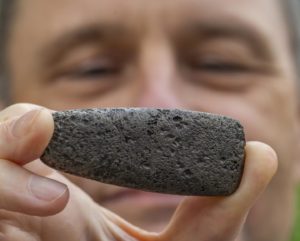
Florida Museum archaeologist Charles Cobb holds an axe head known as a celt, one of more than 80 metal objects likely from the de Soto expedition. To create this distinct shape, a Chickasaw craftsperson reworked Spanish iron to mimic traditional stone versions. Jeff Gage/Florida Museum of Natural History
____________________________
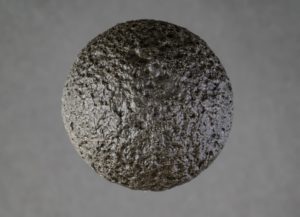
Europeans rarely traded or gifted military items. The presence of objects such as this palm-sized cannonball, lead shot and a ramrod tip at Stark Farms is one reason Cobb and his colleagues believe many of the items were spoils collected after the 1541 battle between the Spaniards and Chickasaws. Jeff Gage/Florida Museum of Natural History
____________________________
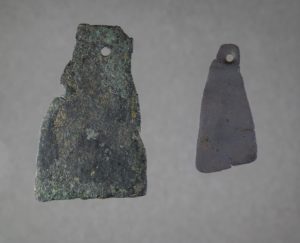
Chickasaws worked Spanish metal into tools and ornaments that reflected local uses and tastes, such as these brass pendants. If the researchers’ diagnosis is correct, Stark Farms, Mississippi is only the second place to yield convincing archaeological evidence of direct contact with de Soto’s expedition. Jeff Gage/Florida Museum of Natural History
____________________________
Article Source: FLORIDA MUSEUM OF NATURAL HISTORY news release. Writer: Natalie van Hoose
James Legg, Steven Smith and Chester DePratter of the South Carolina Institute of Archaeology and Anthropology and Edmond Boudreaux of the University of Mississippi also co-authored the study. The Chickasaw Nation reviewed the study for consistency with its histories.
The Chickasaw Nation and its Chickasaw Explorers Program co-led and funded the research. Portions of the fieldwork were also funded by the National Geographic Society.
____________________________
Advertisement
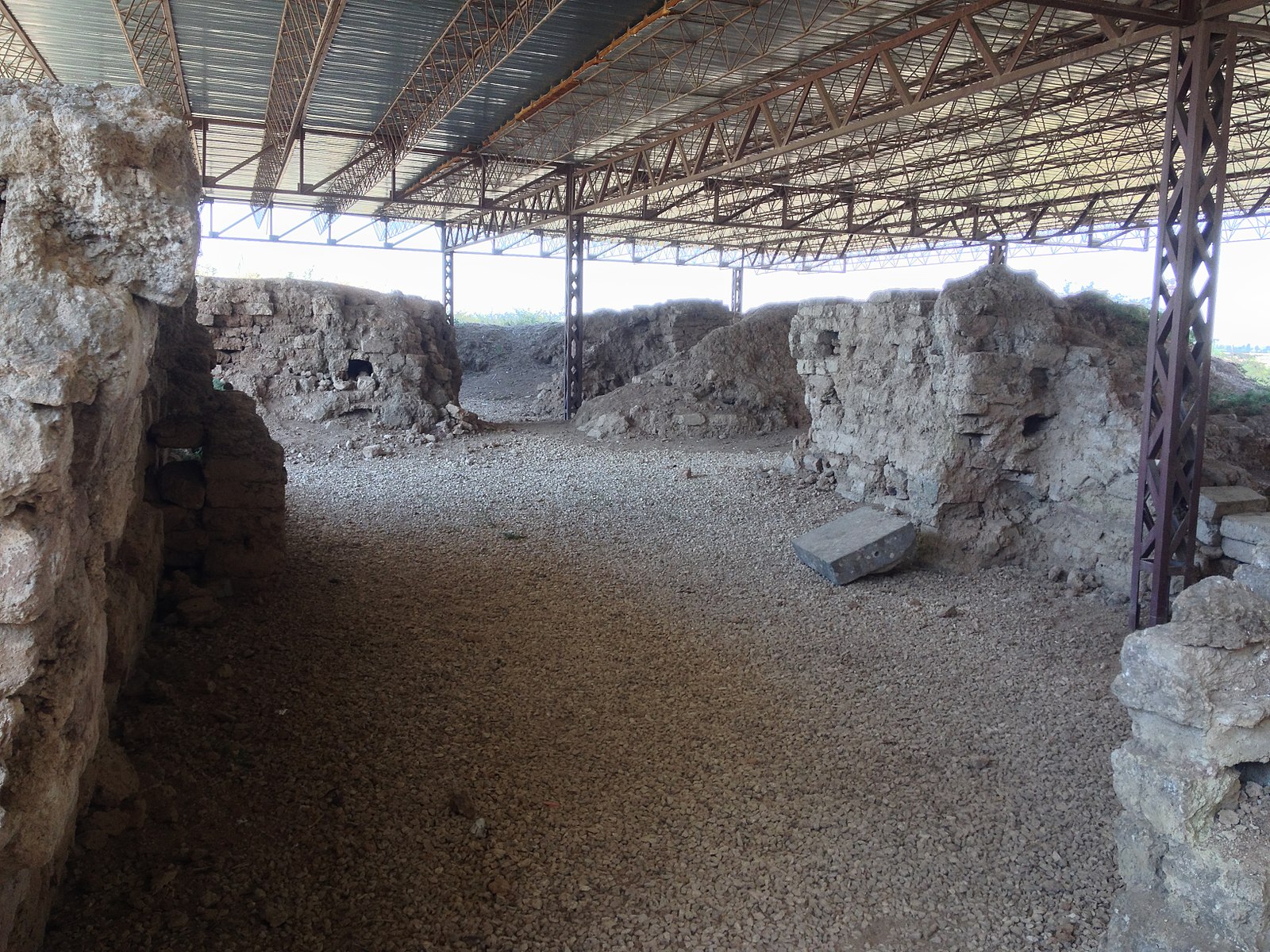
MAX PLANCK INSTITUTE FOR THE SCIENCE OF HUMAN HISTORY—The Bronze Age in the eastern Mediterranean has long been considered by researchers to have been the ‘first international age,’ especially the period from 1600-1200 BC, when powerful empires from Anatolia, Mesopotamia, and Egypt set up large networks of subordinate client kingdoms in the Near East. These empires fought, traded, and corresponded with one another, and ancient texts from the period reveal rich economic and social networks that enabled the movement of people and goods.
A new study conducted by an interdisciplinary team of archaeologists, geneticists, and isotope experts, and published in PLOS ONE, investigated the movement of people in this period at a single regional center, a Bronze Age city-state called Alalakh in present-day southeastern Turkey. Their results indicate that the majority buried at Alalakh were raised locally and descended from people who lived in the region.
The team’s goal was to see if the high levels of interregional connectivity evidenced by the architecture, texts, and artifacts found at the site during 20 years of excavations, sponsored by the Turkish Ministry of Culture and Tourism and Hatay Mustafa Kemal University, could be detected among the population buried at the city.
To do so, they conducted strontium and oxygen isotope analyses on tooth enamel, which can detect whether an individual grew up locally at Alalakh or moved there only during adulthood. The genetic data on the other hand can be used to determine where a person’s recent ancestors came from.
The isotope analysis identified several non-local individuals. However, their DNA showed an ancestry that was local to Alalakh and neighboring regions. “There are two possible explanations for our findings,” said co-lead author Stefanie Eisenmann from the Max Planck Institute for the Science of Human History. “Either these individuals are short-distance migrants from the region or return-migrants, people whose parents or grandparents originally came from Alalakh.”
Only one sampled individual, an adult woman, was not part of the local gene pool, instead showing ancestry that most closely matched groups in Central Asia. However, her isotopic signatures suggested a local upbringing. “We expected the isotope analysis to show that this person immigrated to Alalakh, since her genetic data was so different from the rest of the population, so we were surprised to see that she was likely native to Alalakh. It could have been her parents or grandparents who made the move, instead,” explained Tara Ingman, the other lead-author of the study from Koç University.
While different types of mobility were identified, including short-distance, long-distance, and return migration, there were no complete foreigners in the dataset. Most people were born and raised at Alalakh and also their ancestors came from the region.
“There are several ways to explain this. It is possible that far less long-distance migrants were living at Alalakh than we had previously thought. Another possibility is that we haven’t found their graves, yet. Perhaps most individuals that came from far away were not buried directly at Alalakh, or in a way we cannot trace,” said Murat Akar, director of the excavations.
________________________________
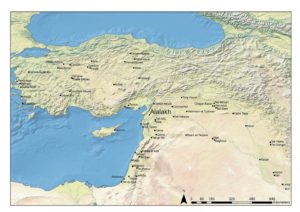
Map showing location of Alalakh in Turkey. Ingman et al., 2021. PLOS ONE.
________________________________

Archaeological site of Alalakh, Tell Atchana, Hatay, Turkey. Fkitselis, Creative Commons Attribution-Share Alike 3.0 Unported license, Wikimedia Commons
________________________________
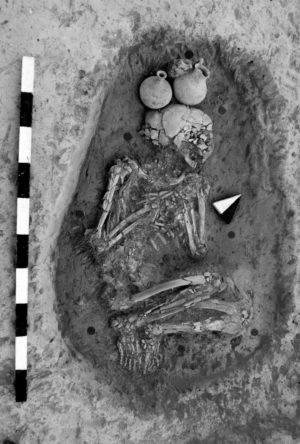
The dead at Alalakh were usually buried in simple pit graves and often with ceramic vessels close to their heads. Murat Akar, Tell Atchana Excavations
________________________________
Article Source: MAX PLANCK INSTITUTE FOR THE SCIENCE OF HUMAN HISTORY news release
________________________________
Advertisement

________________________________

Stone balance weights with weight marks from the Bronze Age tell settlement of Arslantepe (Malatya, Turkey). The weights were found grouped together on the floor of a private house of phase VI D1. Missione Archeologica Italiana nell’Anatolia Orientale/Roberto Ceccacci.
________________________________

Diffusion of weighing technology in Western Eurasia (c. 3000-1000 BCE). Nicola Ialongo.
________________________________
Article Source: PROCEEDINGS OF THE NATIONAL ACADEMY OF SCIENCES news release
*”Bronze Age weight systems as a measure of market integration in Western Eurasia,” by Nicola Ialongo, Raphael Hermann, and Lorenz Rahmstorf.
________________________________
Advertisement
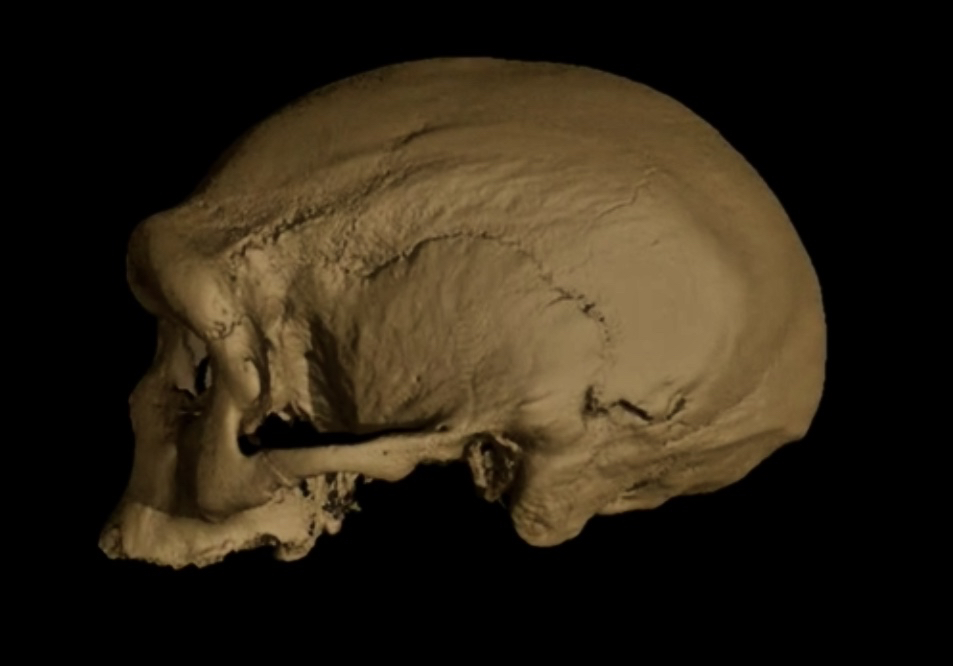
CELL PRESS—A near-perfectly preserved ancient human fossil known as the Harbin cranium sits in the Geoscience Museum in Hebei GEO University. The largest of known Homo skulls, scientists now say this skull represents a newly discovered human species named Homo longi or “Dragon Man.” Their findings, appearing in three papers publishing June 25 in the journal The Innovation, suggest that the Homo longi lineage may be our closest relatives—and has the potential to reshape our understanding of human evolution.
“The Harbin fossil is one of the most complete human cranial fossils in the world,” says author Qiang Ji, a professor of paleontology of Hebei GEO University. “This fossil preserved many morphological details that are critical for understanding the evolution of the Homo genus and the origin of Homo sapiens.”
The cranium was reportedly discovered in the 1930s in Harbin City of the Heilongjiang province of China. The massive skull could hold a brain comparable in size to modern humans’ but had larger, almost square eye sockets, thick brow ridges, a wide mouth, and oversized teeth. “While it shows typical archaic human features, the Harbin cranium presents a mosaic combination of primitive and derived characters setting itself apart from all the other previously-named Homo species,” says Ji, leading to its new species designation of Homo longi.
Scientists believe the cranium came from a male individual, approximately 50 years old, living in a forested, floodplain environment as part of a small community. “Like Homo sapiens, they hunted mammals and birds, and gathered fruits and vegetables, and perhaps even caught fish,” remarks author Xijun Ni, a professor of primatology and paleoanthropology at the Chinese Academy of Sciences and Hebei GEO University. Given that the Harbin individual was likely very large in size as well as the location where the skull was found, researchers suggest H. longi may have been adapted for harsh environments, allowing them to disperse throughout Asia.
Using a series of geochemical analyses, Ji, Ni, and their team dated the Harbin fossil to at least 146,000 years, placing it in the Middle Pleistocene, a dynamic era of human species migration. They hypothesize that H. longi and H. sapiens could have encountered each other during this era.
“We see multiple evolutionary lineages of Homo species and populations co-existing in Asia, Africa, and Europe during that time. So, if Homo sapiens indeed got to East Asia that early, they could have a chance to interact with H. longi, and since we don’t know when the Harbin group disappeared, there could have been later encounters as well,” says author Chris Stringer, a paleoanthropologist at the Nature History Museum in London.
Looking farther back in time, the researchers also find that Homo longi is one of our closest hominin relatives, even more closely related to us than Neanderthals. “It is widely believed that the Neanderthal belongs to an extinct lineage that is the closest relative of our own species. However, our discovery suggests that the new lineage we identified that includes Homo longi is the actual sister group of H. sapiens,” says Ni.
Their reconstruction of the human tree of life also suggests that the common ancestor we share with Neanderthals existed even further back in time. “The divergence time between H. sapiens and the Neanderthals may be even deeper in evolutionary history than generally believed, over one million years,” says Ni. If true, we likely diverged from Neanderthals roughly 400,000 years earlier than scientists had thought.
The researchers say that findings gathered from the Harbin cranium have the potential to rewrite major elements of human evolution. Their analysis into the life history of Homo longi suggest they were strong, robust humans whose potential interactions with Homo sapiens may have shaped our history in turn. “Altogether, the Harbin cranium provides more evidence for us to understand Homo diversity and evolutionary relationships among these diverse Homo species and populations,” says Ni. “We found our long-lost sister lineage.”
_______________________________
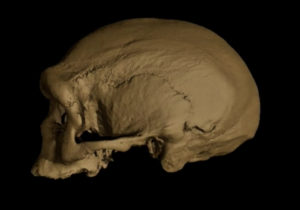
Virtual reconstruction of the Harbin cranium. Xijun Ni
_______________________________

This image shows comparisons among Peking Man, Maba, Jinniushan, Dali and Harbin crania (from left to right). Kai Geng
_______________________________

This image shows a reconstruction of Dragon Man in his habitat. Chuang Zhao
_______________________________
Article Source: CELL PRESS news release
Related papers in Cell Press:
The Innovation, Shao et al.: “Geochemical provenancing and direct dating of the Harbin archaic human cranium” https://www.cell.com/the-innovation/S2666-6758(21)00056-4 DOI: 10.1016/j.xinn.2021.100131
The Innovation, Ji et al.: “Late Middle Pleistocene Harbin cranium represents a new Homo species” https://www.cell.com/the-innovation/S2666-6758(21)00057-6 DOI: 10.1016/j.xinn.2021.100132
The Innovation, Ni et al.: “Massive cranium from Harbin in northeastern China establishes a new Middle Pleistocene human lineage” https://www.cell.com/the-innovation/S2666-6758(21)00055-2 DOI: 10.1016/j.xinn.2021.100130
Funding information for this research is available in the respective papers.
________________________________
Advertisement
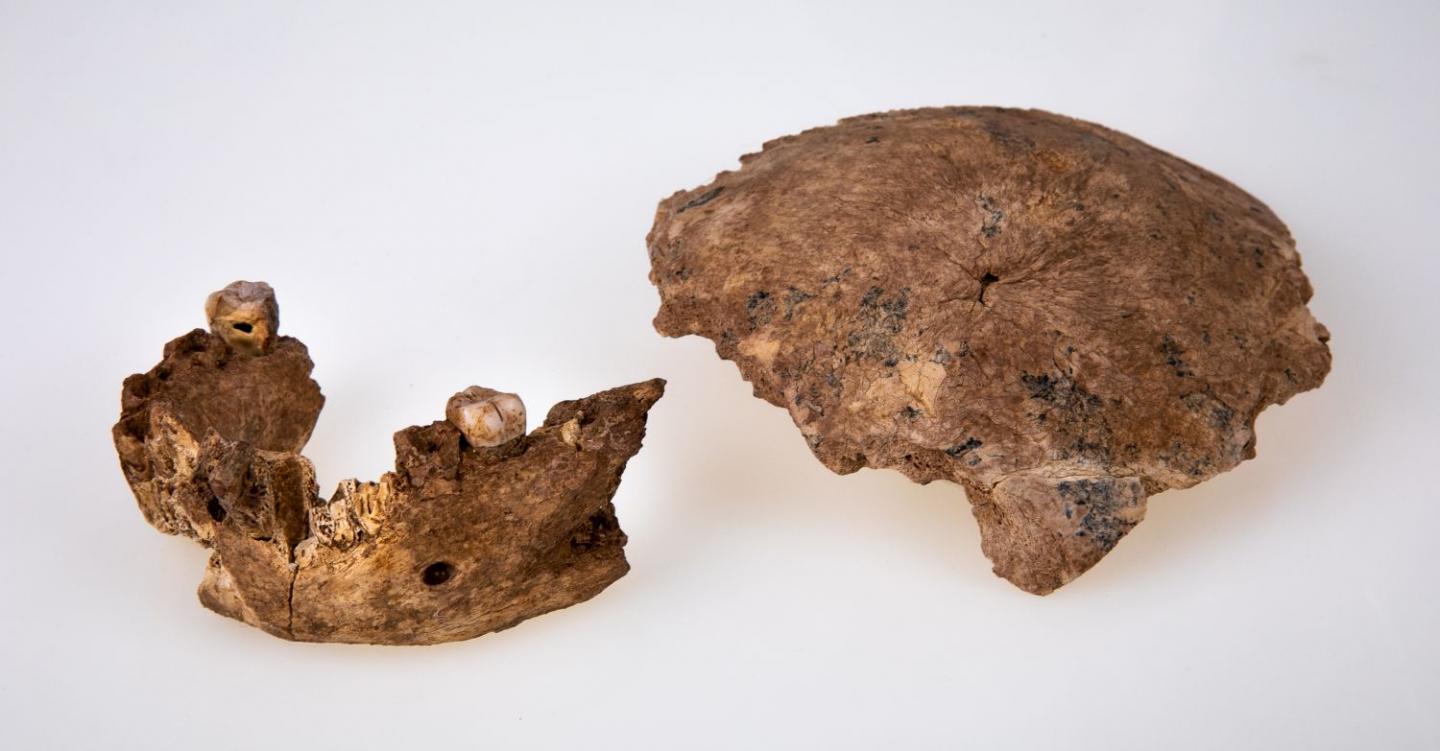
TEL-AVIV UNIVERSITY and AMERICAN ASSOCIATION FOR THE ADVANCEMENT OF SCIENCE—Nesher Ramla Homo type – a prehistoric human previously unknown to science: Researchers from Tel Aviv University and the Hebrew University of Jerusalem have identified a new type of early human at the Nesher Ramla site, dated to 140,000 to 120,000 years ago. According to the researchers, the morphology of the Nesher Ramla humans shares features with both Neanderthals (especially the teeth and jaws) and archaic Homo (specifically the skull). At the same time, this type of Homo is very unlike modern humans – displaying a completely different skull structure, no chin, and very large teeth. Following the study’s findings, researchers believe that the Nesher Ramla Homo type is the ‘source’ population from which most humans of the Middle Pleistocene developed. In addition, they suggest that this group is the so-called ‘missing’ population that mated with Homo sapiens who arrived in the region around 200,000 years ago – about whom we know from a recent study on fossils found in the Misliya cave.
Two teams of researchers took part in the dramatic discovery, published in the prestigious Science journal: an anthropology team from Tel Aviv University headed by Prof. Israel Hershkovitz, Dr. Hila May and Dr. Rachel Sarig from the Sackler Faculty of Medicine and the Dan David Center for Human Evolution and Biohistory Research and the Shmunis Family Anthropology Institute, situated in the Steinhardt Museum at Tel Aviv University; and an archaeological team headed by Dr. Yossi Zaidner from the Institute of Archaeology at the Hebrew University of Jerusalem.
Timeline: The Nesher Ramla Homo type was an ancestor of both the Neanderthals in Europe and the archaic Homo populations of Asia.
Prof.Israel Hershkovitz: “The discovery of a new type of Homo” is of great scientific importance. It enables us to make new sense of previously found human fossils, add another piece to the puzzle of human evolution, and understand the migrations of humans in the old world. Even though they lived so long ago, in the late middle Pleistocene (474,000-130,000 years ago), the Nesher Ramla people can tell us a fascinating tale, revealing a great deal about their descendants’ evolution and way of life.”
The important human fossil was found by Dr. Zaidner of the Hebrew University during salvage excavations at the Nesher Ramla prehistoric site, in the mining area of the Nesher cement plant (owned by Len Blavatnik) near the city of Ramla. Digging down about 8 meters, the excavators found large quantities of animal bones, including horses, fallow deer and aurochs, as well as stone tools and human bones. An international team led by the researchers from Tel Aviv and Jerusalem identified the morphology of the bones as belonging to a new type of Homo, previously unknown to science. This is the first type of Homo to be defined in Israel, and according to common practice, it was named after the site where it was discovered – the Nesher Ramla Homo type.
Dr. Yossi Zaidner: “This is an extraordinary discovery. We had never imagined that alongside Homo sapiens, archaic Homo roamed the area so late in human history. The archaeological finds associated with human fossils show that “Nesher Ramla Homo” possessed advanced stone-tool production technologies and most likely interacted with the local Homo sapiens“. The culture, way of life, and behavior of the Nesher Ramla Homo are discussed in a companion paper also published in Science journal today.
Prof. Hershkovitz adds that the discovery of the Nesher Ramla Homo type challenges the prevailing hypothesis that the Neanderthals originated in Europe. “Before these new findings,” he says, “most researchers believed the Neanderthals to be a ‘European story’, in which small groups of Neanderthals were forced to migrate southwards to escape the spreading glaciers, with some arriving in the Land of Israel about 70,000 years ago. The Nesher Ramla fossils make us question this theory, suggesting that the ancestors of European Neanderthals lived in the Levant as early as 400,000 years ago, repeatedly migrating westward to Europe and eastward to Asia. In fact, our findings imply that the famous Neanderthals of Western Europe are only the remnants of a much larger population that lived here in the Levant – and not the other way around.”
According to Dr. Hila May, despite the absence of DNA in these fossils, the findings from Nesher Ramla offer a solution to a great mystery in the evolution of Homo: How did genes of Homo sapiens penetrate the Neanderthal population that presumably lived in Europe long before the arrival of Homo sapiens? Geneticists who studied the DNA of European Neanderthals have previously suggested the existence of a Neanderthal-like population which they called the ‘missing population’ or the ‘X population’ that had mated with Homo sapiens more than 200,000 years ago. In the anthropological paper now published in Science, the researchers suggest that the Nesher Ramla Homo type might represent this population, heretofore missing from the record of human fossils. Moreover, the researchers propose that the humans from Nesher Ramla are not the only ones of their kind discovered in the region, and that some human fossils found previously in Israel, which have baffled anthropologists for years – like the fossils from the Tabun cave (160,000 years ago), Zuttiyeh cave (250,000), and Qesem cave (400,000) – belong to the same new human group now called the Nesher Ramla Homo type.
“People think in paradigms,” says Dr. Rachel Sarig. “That’s why efforts have been made to ascribe these fossils to known human groups like Homo sapiens, Homo erectus, Homo heidelbergensis or the Neanderthals. But now we say: No. This is a group in itself, with distinct features and characteristics. At a later stage small groups of the Nesher Ramla Homo type migrated to Europe – where they evolved into the ‘classic’ Neanderthals that we are familiar with, and also to Asia, where they became archaic populations with Neanderthal-like features. As a crossroads between Africa, Europe and Asia, the Land of Israel served as a melting pot where different human populations mixed with one another, to later spread throughout the Old World. The discovery from the Nesher Ramla site writes a new and fascinating chapter in the story of humankind.”
The findings indicate that this archaic lineage may represent one of the last surviving populations of Middle Pleistocene Homo in southwest Asia, Africa and Europe. In a companion study, Zaidner et al. provide the archaeological context of the new fossils, reporting on the associated radiometric ages, artifact assemblages and the behavioral and environmental insights they offer. Zaidner et al. show that the Nesher Ramla Homo were well versed in technologies that were previously only known among H. sapiens and Neanderthals. Together, the findings provide archaeological support for close cultural interactions and genetic admixture between different human lineages before 120,000 years ago. This may help explain the variable expression of the dental and skeletal features of later Levantine fossils. “The interpretation of the Nesher Ramla fossils and stone tools will meet with different reactions among paleoanthropologists. Notwithstanding, the age of the Nesher Ramla material, the mismatched morphological and archaeological affinities, and the location of the site at the crossroads of Africa and Eurasia make this a major discovery,” writes Marta Lahr in an accompanying Perspective.
Prof. Gerhard Weber, an associate from Vienna University, argues that the story of Neanderthal evolution will be told differently after this discovery: “Europe was not the exclusive refugium of Neanderthals from where they occasionally diffused into West Asia. We think that there was much more lateral exchange in Eurasia, and that the Levant is geographically a crucial starting point, or at a least bridgehead, for this process.”
______________________________
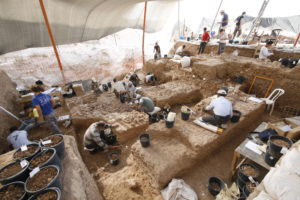
Field excavation at Nesher Ramla. View of the excavation. Yossi Zaidner
______________________________
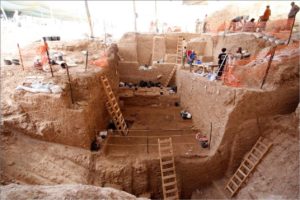
View of the deep section during excavation at Nesher Ramla. Photograph showing the deep
archaeological sequence. Yossi Zaidner
______________________________
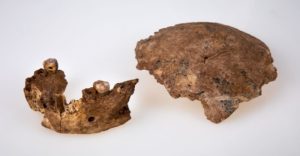
Fossil remains of skull and jaw Tel Aviv University
______________________________
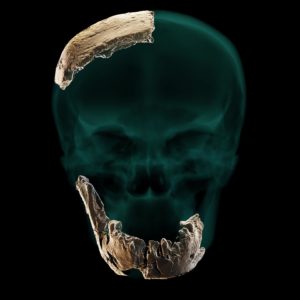
Static skull & mandible & parietal orthographic. Tel Aviv University
______________________________
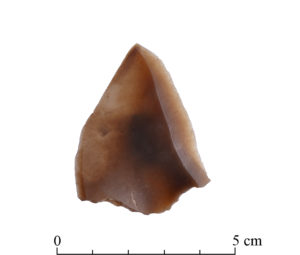
A stone tool of the Nesher Ramla Homo – Levallois point. Tal Rogovski
______________________________
Research Summary of Findings and Conclusions:
Article Source: TEL-AVIV UNIVERSITY and AMERICAN ASSOCIATION FOR THE ADVANCEMENT OF SCIENCE news releases.
Advertisement
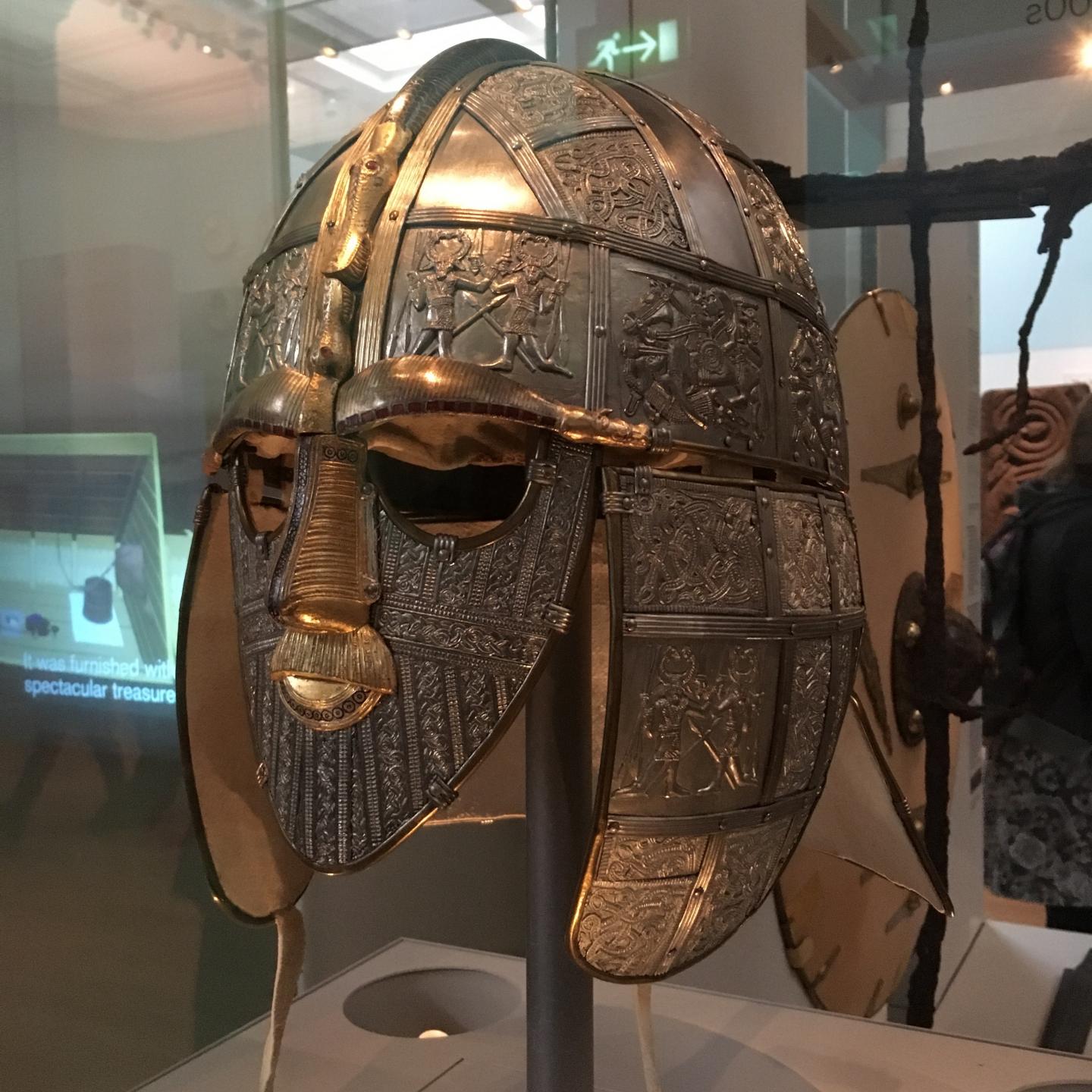
UNIVERSITY OF SYDNEY—A new study from archaeologists at University of Sydney and Simon Fraser University in Vancouver, has provided important new evidence to answer the question “Who exactly were the Anglo-Saxons?”
New findings based on studying skeletal remains clearly indicates the Anglo-Saxons were a melting pot of people from both migrant and local cultural groups and not one homogenous group from Western Europe.
Professor Keith Dobney at the University of Sydney said the team’s results indicate that “the Anglo-Saxon kingdoms of early Medieval Britain were strikingly similar to contemporary Britain – full of people of different ancestries sharing a common language and culture”.
The Anglo-Saxon (or early medieval) period in England runs from the 5th-11th centuries AD. Early Anglo-Saxon dates from around 410-660 AD – with migration occurring throughout all but the final 100 years (ie 410-560AD).
Studying ancient skulls
Published in PLOS ONE, the collaborative study by Professor Dobney at University of Sydney and Dr Kimberly Plomp and Professor Mark Collard at Simon Fraser University in Vancouver, looked at the three-dimensional shape of the base of the skull.
“Previous studies by palaeoanthropologists have shown that the base of the human skull holds a shape signature that can be used to track relationships among human populations in a similar way to ancient DNA,” Dr Plomp said. “Based on this, we collected 3D data from suitably dated skeletal collections from Britain and Denmark, and then analysed the data to estimate the ancestry of the Anglo-Saxon individuals in the sample.”
The researchers found that between two-thirds and three-quarters of early Anglo-Saxon individuals were of continental European ancestry, while between a quarter and one-third were of local ancestry.
When they looked at skeletons dated to the Middle Anglo-Saxon period (several hundred years after the original migrants arrived), they found that 50 to 70 percent of the individuals were of local ancestry, while 30 to 50 percent were of continental European ancestry, which probably indicates a change in the rate of migration and/or local adoption of culture over time.
“These findings tell us that being Anglo-Saxon was more likely a matter of language and culture, not genetics,” Professor Collard said.
The debate about Anglo-Saxons
Although Anglo-Saxon origins can clearly be traced to a migration of Germanic-speaking people from mainland Europe between the 5th and 7th centuries AD, the number of individuals who settled in Britain is still contested, as is the nature of their relationship with the pre-existing inhabitants of the British Isles, most of whom were Romano-Celts.
The ongoing and unresolved argument is whether hordes of European invaders largely replaced the existing Romano-British inhabitants, or did smaller numbers of migrants settle and interact with the locals, who then rapidly adopted the new language and culture of the Anglo-Saxons?
“The reason for the ongoing confusion is the apparent contradiction between early historical texts (written sometime after the events that imply that the newcomers were both numerous and replaced the Romano-British population) and some recent biomolecular markers directly recovered from Anglo-Saxon skeletons that appears to suggest numbers of immigrants were few,” said Professor Dobney.
“Our new data sits at the interface of this debate and implies that early Anglo-Saxon society was a mix of both newcomers and immigrants and, instead of wholesale population replacement, a process of acculturation resulted in Anglo-Saxon language and culture being adopted wholesale by the local population.”
“It could be this new cultural package was attractive, filling a vacuum left at the end of the Roman occupation of Britain. Whatever the reason, it lit the fuse for the English nation we have today – still comprised of people of different origins who share the same language,” Professor Dobney said.
_____________________________
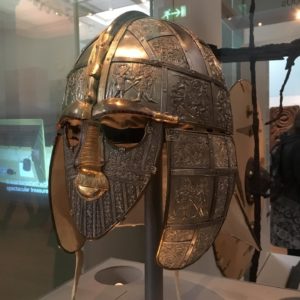
The famous Anglo-Saxon Sutton Hoo helmet from about 625 CE, part of the British Museum collection. Elissa Blake/University of Sydney
_____________________________
Article Source: UNIVERSITY OF SYDNEY news release.
_____________________________
Advertisement
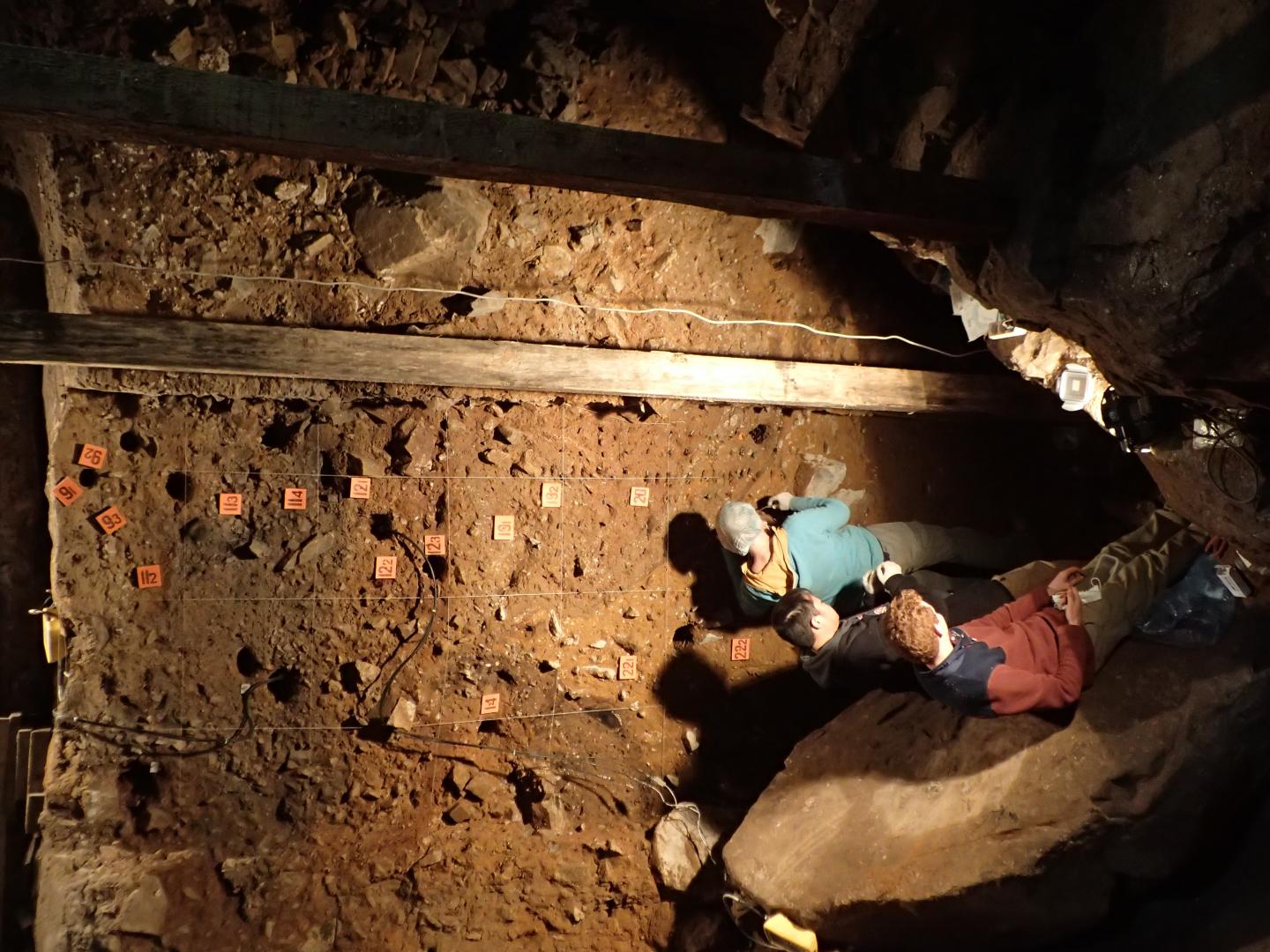
MAX PLANCK INSTITUTE FOR EVOLUTIONARY ANTHROPOLOGY—Denisova Cave is located in the Altai Mountains in southern Siberia and is famous for the discovery of Denisovans, an extinct form of archaic humans that is thought to have occupied large parts of central and eastern Asia. Neanderthal remains have also been found at the site, as well as a bone from a child who had a Neanderthal mother and Denisovan father, showing that both groups met in the region. However, only eight bone fragments and teeth of Neanderthals and Denisovans have been recovered so far from the deposits in Denisova Cave, which cover a time span of over 300,000 years. These are too few fossils to reconstruct the occupational history of the site in detail, or to link the different types of stone tools and other artifacts found in Denisova Cave to specific hominin groups. For example, the discovery of jewelry and pendants typical of the so-called Initial Upper Palaeolithic culture in approximately 45,000-year-old layers has prompted debates as to whether Denisovans, Neanderthals or modern humans were the creators of these artefacts.
Michael Shunkov of the Siberian Branch of the Russian Academy of Sciences, who leads the excavations at Denisova Cave, assembled an interdisciplinary team of archaeologists, geneticists, geochronologists and other scientists to study this unique site. The team has now performed the largest analysis ever of sediment DNA from a single excavation site. “The analysis of sediment DNA provides a wonderful opportunity to combine the dates that we previously determined for the deposits in Denisova Cave with molecular evidence for the presence of people and fauna”, says Richard ‘Bert’ Roberts from the University of Wollongong in Australia. The team of geochronologists led by him and Zenobia Jacobs collected more than 700 sediment samples in a dense grid from the exposed sediment profiles in the cave. “Just collecting the samples from all three chambers in the cave, and documenting their precise locations, took us more than a week”, Jacobs says.
When the samples arrived at the Max Planck Institute for Evolutionary Anthropology in Leipzig, Elena Zavala, the lead author of the study, spent another two years in the lab to extract and sequence small traces of ancient hominin and animal mitochondrial DNA from this huge collection of samples. “These efforts paid off and we detected the DNA of Denisovans, Neanderthals or ancient modern humans in 175 of the samples”, Zavala says.
When matching the DNA profiles with the ages of the layers, the researchers found that the earliest hominin DNA belonged to Denisovans, indicating that they produced the oldest stone tools at the site between 250,000 and 170,000 years ago. The first Neanderthals arrived towards the end of this time period, after which both Denisovans and Neanderthals frequented the site – except between 130,000 and 100,000 years ago, when no Denisovan DNA was detected in the sediments. The Denisovans who came back after this time carried a different mitochondrial DNA, suggesting that a different population arrived in the region.
Modern human mitochondrial DNA first appears in the layers containing Initial Upper Palaeolithic tools and other objects, which are much more diverse than in the older layers. “This provides not only the first evidence of ancient modern humans at the site, but also suggests that they may have brought new technology into the region with them”, says Zavala.
The scientists studied animal DNA and identified two time periods where changes occurred in both animal and hominin populations. The first, around 190,000 years ago, coincided with a shift from relatively warm (interglacial) conditions to a relatively cold (glacial) climate, when hyaena and bear populations changed and Neanderthals first appeared in the cave. The second major change occurred between 130,000 and 100,000 years ago, along with a shift in climate from relatively cold to relatively warm conditions. During this period, Denisovans were absent and animal populations changed again.
“I believe that our Russian colleagues who excavate this amazing site have set the standards for many future archaeological excavations with their careful collection of many samples from each archaeological layer for DNA analysis”, says Svante Pääbo who initiated the study with the Russian team. “Being able to generate such dense genetic data from an archaeological site is like a dream come true, and these are just the beginnings”, says Matthias Meyer, the senior author on the study. “There is so much information hidden in sediments – it will keep us and many other geneticists busy for a lifetime.”
________________________________
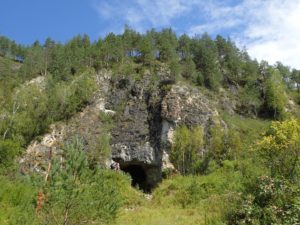
The entrance to Denisova Cave, the famous site in southern Siberia where remains of both Neandertals and their Asian relatives, the Denisovans, have been found. Richard G. Roberts
________________________________
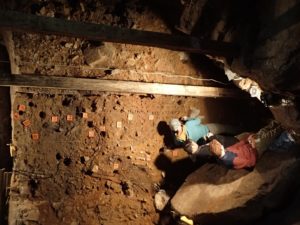
Researchers Zenobia Jacobs, Bo Li and Kieran O’Gorman collecting sediment samples in the Main Chamber. Richard G. Roberts
________________________________
Article Source: MAX PLANCK INSTITUTE FOR EVOLUTIONARY ANTHROPOLOGY news release.
________________________________
Advertisement

UNIVERSITY OF CINCINNATI—The ancient Maya city of Tikal was a bustling metropolis and home to tens of thousands of people.
The city comprised roads, paved plazas, towering pyramids, temples and palaces and thousands of homes for its residents, all supported by agriculture.
Now researchers at the University of Cincinnati say Tikal’s reservoirs — critical sources of city drinking water — were lined with trees and wild vegetation that would have provided scenic natural beauty in the heart of the busy city.
UC researchers developed a novel system to analyze ancient plant DNA in the sediment of Tikal’s temple and palace reservoirs to identify more than 30 species of trees, grasses, vines and flowering plants that lived along its banks more than 1,000 years ago. Their findings paint a picture of a lush, wild oasis.
“Almost all of the city center was paved. That would get pretty hot during the dry season,” said paleoethnobotanist David Lentz, a professor of biology in UC’s College of Arts and Sciences and lead author of the study.
“So it would make sense that they would have places that were nice and cool right along the reservoir,” he said. “It must have been beautiful to look at with the water and trees and a welcome place for the kings and their families to go.”
The study was published in the Nature journal Scientific Reports.
Lentz and his research team offered four hypotheses about what, if any, plants might have grown along the all-important reservoirs: Did the Maya grow crops such as maize or squash there? Or did they plant fruit trees like those found at a similar reservoir at Mexico’s Purron Dam?
Maybe they lined the reservoirs with cattails in keeping with their nickname people of the reeds? Lentz noted that water lilies often adorn ancient Maya paintings.
“Throughout Maya iconography, water lilies represent continuity between the water world and the above world,” Lentz said. “It was part of their mythology.”
But researchers found little evidence to support any of these hypotheses. Instead, they found evidence bolstering a fourth idea: that the Maya allowed the embankments to remain undisturbed forest. This would have helped to prevent erosion and provided medicinal or edible plants and fruits.
Researchers found evidence of a variety of plants living along the aquifers, including trees like cabbage bark and ramón that tower 100 feet high. Lentz said ramón is a dominant rainforest species in Guatemala.
“Why you would find ramón around the reservoir is a curiosity. The answer is they left this forest intact,” Lentz said. “Tikal has a harsh climate. It’s pretty tough to survive when you don’t get rain for five months of the year. This reservoir would have been the font of their lives. So they sometimes would protect these places by not cutting down the trees and preserving a sacred grove.”
Among dozens of plants native to the region, they found evidence of wild onion, fig, wild cherry and two types of grasses. Lentz said grass seeds might have been introduced to the reservoir by visiting waterfowl. Grass would have proliferated at the edges of the reservoirs during dry seasons and droughts.
“Tikal had a series of devastating droughts. As the water levels dropped, they saw blue green algae blooms, which produces toxic substances,” Lentz said. “The droughts were great for the grass but not so much for the forest plants that lived along the reservoir’s banks.”
Were these wild areas the equivalent of a park?
“I think they were. I don’t know how public they would have been,” Lentz said. “This was a sacred area of the city surrounded by temples and palaces. I don’t know if the commoners would have been that welcome.”
Tikal was a flourishing seat of power, religion and trade for Mesoamerica in what is now northern Guatemala, reaching its peak of influence more than 1,200 years ago. Today, the cultural and archaeological site is a scenic national park surrounded by primary rainforest.
But more than 1,000 years ago, the area would have looked dramatically different. Instead of rainforest, the city center would have been surrounded by homes and farm plots of corn, beans and squash needed to support 60,000 people or more. At its peak, Tikal was bigger in population than Wilkes-Barre, Pennsylvania; Atlantic City, New Jersey; or Pensacola, Florida.
Given the documented and widespread deforestation that occurred around Tikal during the city’s rise and fall, the presence of an intact forest in the city would have stood out, said Nicholas Dunning, a UC geography professor and study co-author.
“It would not have been much of a park — maybe 50 meters by 50 meters,” Dunning said. “But it would have been in vivid contrast to the surrounding area of the city’s central precinct, which was essentially entirely paved with plaster with many of the buildings colored red.”
The reservoirs would have held significance beyond their value as an important source of water, he said.
“Given that the Maya were a forest culture whose cosmology included many forest elements (for example, certain sacred trees that held up the sky) having a sacred grove adjacent to the sacred spring and pool at the heart of the city was an extremely potent symbol — kind of like parts of the cosmos in miniature,” Dunning said. “On the other hand, ancient Maya cities as a whole were very green.”
Tikal put today’s urban gardens to shame.
“Away from the central precinct of Tikal, most of the land was either managed trees or crops,” Dunning said. “Just about every household complex had significant gardens. A great deal of the food consumed by the residents of Maya cities was probably grown within the city itself or its immediate hinterland. Nothing much like a modern Western city.”
Previously, researchers learned about the crops and wild plants that grew in ancient Tikal by studying ancient pollen or charcoal, Lentz said. For their study, UC turned to next-generation DNA sequencing that can identify plants and animals with even small strands of DNA.
“Typically, high-quality, high-concentration DNA is needed for next-gen work,” UC botanist and study co-author Eric Tepe said. “The Tikal samples were both poor quality and very low concentration.”
Microbiologists Alison Weiss, a professor in UC’s College of Medicine, and Trinity Hamilton, now with the University of Minnesota, took up the task of analyzing ancient microbial DNA from the reservoir’s sediment samples.
Weiss studies pathogenic E. coli and human microbiomes in her lab. Her latest work examined how chemotherapy in cancer patients impairs the protective lining of their digestive systems. But she likes all science, she said, and was eager to accept a new challenge.
“The DNA is ancient so it tends to be degraded with short little sequences,” Weiss said.
With the help of the Florida company Rapid Genomics, UC’s scientists developed a novel probe to select plant DNA in the sediment samples. And they were able to amplify small strands of DNA from chloroplasts, the plant structures where photosynthesis takes place. Then researchers could match the ancient Tikal samples with the DNA of known plant species in much the same way scientists amplify ribosomal DNA to identify species of bacteria.
“The analysis was quite challenging because we were the first to do this,” Weiss said. “Bacterial ribosomal DNA has a database. There was no database for this. We had to take sequences one by one and search the general database to find the best match.”
“This project was a bit of a shot in the dark,” Tepe said. “We half-expected to get no results at all. The fact that we were able to get an idea of the vegetation surrounding the reservoirs at Tikal is, in my opinion, a spectacular success and a proof of concept that we hope to apply to other Mayan sites.”
UC researchers can now study the ancient world in a promising new way.
“We’re delighted we had success,” Weiss said. “It took a long time to figure out how to do it and make sure it wasn’t junk data in, junk data out. Now to be able to learn more about ancient people from these sediment studies is very exciting.”
_____________________________
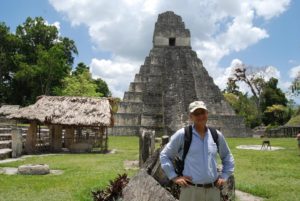
University of Cincinnati biology professor David Lentz stands in front of a pyramid at Tikal in Guatemala. UC
_____________________________
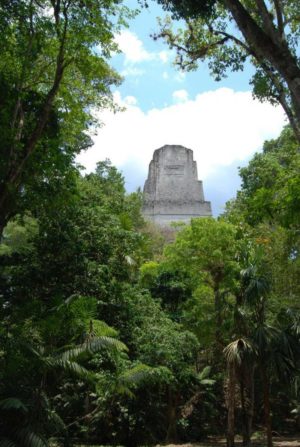
A pyramid at Tikal rises from the rainforest in Guatemala. David Lentz
_____________________________
Article Source: UNIVERSITY OF CINCINNATI news release
_____________________________
Advertisement
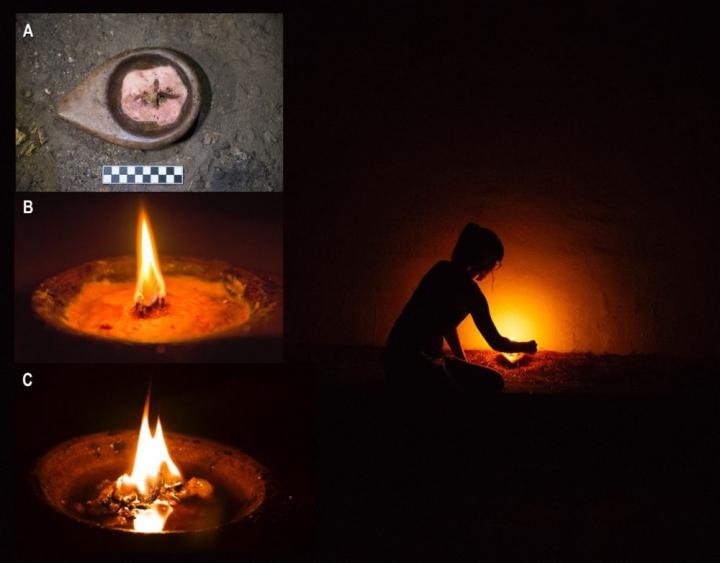
PLOS—A recreation of three common types of Paleolithic lighting systems (torches, grease lamps, and fireplaces) illuminates how Paleolithic cave dwellers might have traveled, lived, and created in the depths of their caves, according to a study published June 16, 2021 in the open-access journal PLOS ONE by Mª Ángeles Medina-Alcaide from the University of Cantabria, Spain, and colleagues.
Humans need light to access the deepest areas of caves–and these visits also depend on the type of light available, as light intensity and duration, area of illumination, and color temperature all determine how the cave environment can be used. In this study, Medina-Alcaide and colleagues use archaeological evidence of lighting remains found across several Paleolithic caves featuring cave art in Southwest Europe to experimentally replicate the artificial lighting systems presumably used by the original human cave dwellers, allowing immediate empirical observations.
The authors conducted their experiments at Isuntza 1 Cave in the Basque region of Spain. Their replicated lighting was based as much as possible on archaeological evidence found in similar Paleolithic caves, and included five replicated torches (made variably from ivy, juniper, oak, birch, and pine resins), two stone lamps using animal fat (bone marrow from cow and deer), and a small fireplace (oak and juniper wood).
They found that the different lighting systems all had diverse features, suggesting their likely selection and use across different contexts. Wooden torches made of multiple sticks worked best for exploring caves or crossing wide spaces, since they projected light in all directions (up to almost six meters in the experiments), were easy to transport, and didn’t dazzle the torchbearer despite having a light intensity almost five times greater than a double-wicked grease lamp. Torch light lasted for an average of 41 minutes in this study, with the shortest-lived torch burning 21 minutes, and the longest burning 61 minutes. The torches tended to function irregularly and required close supervision when burning–though they were easy to relight via oxygenation (moving the torch quickly side to side). The authors found the main torch disadvantage was the amount of smoke production. In contrast, grease lamps worked best for lighting small spaces over a long period–with a light intensity similar to a candle, they were able to light up to three meters (or more if larger or multiple wicks were added). Though grease lamps weren’t well-suited for transit due to their dazzling effect and poor floor illumination, they burned consistently and without much smoke for well over an hour, complementing the use of torches. The authors made one fireplace, a static system, which burned very smokily and was extinguished after 30 minutes. They note that the location was likely not appropriate due to air currents in the cave.
The authors note that the practical insights and observations gained from their experimental replications are invaluable for a deeper understanding of what it may have been like to access the darkest parts of inhabited caves, especially in order to create art, and emphasize that future experimental lighting studies will be useful in continuing to unravel our ancestors’ activities in their caves.
The authors add: “The artificial lighting was a crucial physical resource for expanding complex social and economic behavior in Paleolithic groups, especially for the development of the first palaeo-speleological explorations and for the origin of art in caves.”
__________________________________
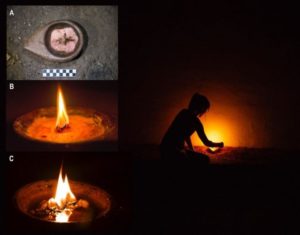
Set of photographs of stone lamp experiment. Medina-Alcaide et al, 2021, PLOS ONE
__________________________________
Article Source: PLOS news release
*Medina-Alcaide MÁ, Garate D, Intxaurbe I, Sanchidrián JL, Rivero O, Ferrier C, et al. (2021) The conquest of the dark spaces: An experimental approach to lighting systems in Paleolithic caves. PLoS ONE 16(6): e0250497. https:/
Funding: This paper has been funded by the research projects “Before art: social investment in symbolic expressions during the Upper Paleolithic in the Iberian Peninsula” (PID2019-107262 GB-I00), PI: Diego Garate, and “Learning and development of artistic abilities in Anatomically Modern Humans; a multidisciplinary approach (ApArt)” HAR2017-87739-P, PI: Olivia Rivero, both funded by the Ministry of Science, Innovation, and Universities (Spain). Besides, the University of Cordoba (José Luis Sanchidrián, Economic Unit in Prehistory) has collaborated in the publication of this paper in open access. I.I.’s Ph.D. research is funded by a grant for the training of research personnel (PIF 2019) at the University of the Basque Country (UPV/EHU). Lastly, this paper publishes a part of M.M.A.’s thesis. This PhD was financed by the Ministry of Education, Culture, and Sport of Spain (FPU fellowship 2014-2018).
_____________________________________
Advertisement
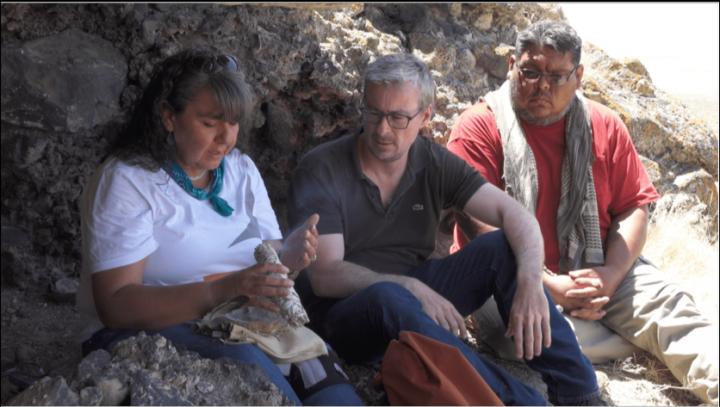
ST JOHN’S COLLEGE, UNIVERSITY OF CAMBRIDGE—A ball of 4,000-year-old hair frozen in time tangled around a whalebone comb led to the first ever reconstruction of an ancient human genome just over a decade ago.
The hair, which was preserved in arctic permafrost in Greenland, was collected in the 1980s and stored at a museum in Denmark. It wasn’t until 2010 that evolutionary biologist Professor Eske Willerslev was able to use pioneering shotgun DNA sequencing to reconstruct the genetic history of the hair.
He found it came from a man from the earliest known people to settle in Greenland known as the Saqqaq culture. It was the first time scientists had recovered an entire ancient human genome.
Now a review of the first decade of ancient genomics of the Americas published in Nature today (June 16 2021) written by Professor Willerslev, a Fellow of St John’s College, University of Cambridge, and director of The Lundbeck Foundation GeoGenetics Centre, University of Copenhagen, with one of his longstanding collaborators Professor David Meltzer, an archaeologist based at Southern Methodist University, Texas, shows how the world’s first analysis of an ancient genome sparked an incredible ‘decade of discovery’.
Professor Willerslev said: “The last ten years has been full of surprises in the understanding of the peopling of the Americas – I often feel like a child at Christmas waiting to see what exciting DNA present I am about to unwrap! What has really blown my mind is how resilient and capable the early humans we have sequenced DNA from were – they occupied extremely different environments and often populated them in a short space of time.
“We were taught in school that people would stay put until the population grew to a level where the resources were exhausted. But we found people were spreading around the world just to explore, to discover, to have adventures.
“The last 10 years have shown us a lot about our history and what it means to be human. We won’t ever see that depth of human experience on this planet again – people entered new areas with absolutely no idea of what was in front of them. It tells us a lot about human adaptability and how humans behave.”
For decades, scientists relied on archaeological findings to reconstruct the past and theories weren’t always accurate. It was previously thought that there were early non-Native American people in the Americas but the ancient DNA analysis so far has shown that all of the ancient remains found are more closely related to contemporary Native Americans than to any other population anywhere else in the world.
Professor Meltzer, who worked on the review with Professor Willerslev while the former was at St John’s College as a Beaufort Visiting Scholar added: “Genomic evidence has shown connections that we didn’t know existed between different cultures and populations and the absence of connections that we thought did exist. Human population history has been far more complex than previously thought.
“A lot of what has been discovered about the peopling of the Americas could not have been predicted. We have seen how rapidly people were moving around the world. When they have a continent to themselves, there was nothing to hold them back. There was a selective advantage to seeing what was over the next hill.”
In 2013, scientists mapped the genome of a four-year-old boy who died in south-central Siberia 24,000 years ago. The burial of an Upper Palaeolithic Siberian child was discovered in the 1920s by Russian archaeologists near the village of Mal’ta, along the Belaya river. Sequencing of the Mal’ta genome was key as it showed the existence of a previously unsampled population that contributed to the ancestry of Siberian and Native American populations.
Two years later, Professor Willerslev and his team published the first ancient Native American genome, sequenced from the remains of a baby boy ceremonially buried more than 12,000 years ago in Anzick, Montana.
In 2015, their ancient genomic analysis was able to solve the mystery of Kennewick Man, one of the oldest and most complete skeletons ever found in the Americas, and one of the most controversial.
The 9,000-year-old remains had been surrounded by a storm of controversy when legal jurisdiction over the skeleton became the focus of a decade of lawsuits between five Native American tribes, who claimed ownership of the man they called Ancient One, and the United States Army Corps of Engineers.
Professor Willerslev, who has rightly learnt to be mindful of cultural sensitivities when searching for ancient DNA, has spent much of the past decade talking to tribal community members to explain his work in detail and seek their support.
This meant he was able to agree with members of the Colville Tribe, based in Washington State where the remains were found, that they would donate some of their DNA to allow Professor Willerslev and his team to establish if there was a genetic link between them and Kennewick Man.
Jackie Cook, a descendant of the Colville Tribe and the repatriation specialist for the Confederated Tribes of the Colville Reservation, said: “We had spent nearly 20 years trying to have the Ancient One repatriated to us. There has been a long history of distrust between scientists and our Native American tribes but when Eske presented to us about his DNA work on the Anzick child, the hair on my arms stood up.
“We knew we shouldn’t have to agree to DNA testing, and there were concerns that we would have to do it every time to prove cultural affiliation, but our Council members discussed it with the elders and it was agreed that any tribal member who wanted to provide DNA for the study could.”
The Kennewick Man genome, like the Anzick baby, revealed the man was a direct ancestor of living Native Americans. The Ancient One was duly returned to the tribes and reburied.
Cook added: “We took a risk but it worked out. It was remarkable to work with Eske and we felt honored, relieved and humbled to be able to resolve such an important case. We had oral stories that have passed down through the generations for thousands of years that we call coyote stories – teaching stories. These stories were from our ancestors about living alongside woolly mammoths and witnessing a series of floods and volcanoes erupting. As a tribe, we have always embraced science but not all history is discovered through science.”
Work led by Professor Willerslev was also able to identify the origins of the world’s oldest natural mummy called Spirit Cave. Scientists discovered the ancient human skeleton back in 1940 but it wasn’t until 2018 that a striking discovery was made that unlocked the secrets of the Ice Age tribe in the Americas.
The revelation came as part of a study that genetically analyzed the DNA of a series of famous and controversial ancient remains across North and South America including Spirit Cave, the Lovelock skeletons, the Lagoa Santa remains, an Inca mummy, and the oldest remains in Chilean Patagonia.
Scientists sequenced 15 ancient genomes spanning from Alaska to Patagonia and were able to track the movements of the first humans as they spread across the Americas at ‘astonishing’ speed during the Ice Age and also how they interacted with each other in the following millennia.
The team of academics not only discovered that the Spirit Cave remains was a Native American but they were able to dismiss a longstanding theory that a group called Paleoamericans existed in North America before Native Americans. Spirit Cave was returned to The Fallon Paiute-Shoshone Tribe, a group of Native Americans based in Nevada, for burial.
Professor Willerslev added: “Over the past decade human history has been fundamentally changed thanks to ancient genomic analysis – and the incredible findings have only just begun.”
______________________________
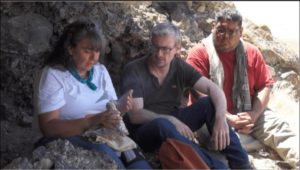
Professor Eske Willerslev with Donna and Joey, two members of the Fallon Paiute-Shoshone tribe, discussing the Spirit Cave individual. Linus Mørk/Magus Film.
______________________________
Article Source: ST JOHN’S COLLEGE, UNIVERSITY OF CAMBRIDGE news release
If you liked this article, you may also like Spirit Cave: The World’s Oldest Natural Mummy, an in-depth premium article published previously at Popular Archaeology.
______________________________
Advertisement

UNIVERSITY OF COLOGNE—An international research team led by Professor Dr Frank Schäbitz has published a climate reconstruction of the last 200,000 years for Ethiopia. This means that high-resolution data are now available for the period when early Homo sapiens, our ancestors, made their way from Africa to Europe and Asia. Schäbitz and his colleagues determined the dates using a drill core of lake sediments deposited in southern Ethiopia’s Chew Bahir Basin, which lies near human fossil sites. Temporal resolution of the samples, reaching nearly 10 years, revealed that from 200,000 to 125,000 years before our time, the climate there was relatively wet, providing enough water and thus abundant plant and animal food resources in the lowlands of East Africa. From 125,000 to 60,000 years ago, it gradually became drier, and particularly dry between 60,000 to 14,000 years ago. The data now obtained fit well with genetic findings, according to which our direct genetic ancestors (‘African Eve’) left Africa ‘successfully’ during a wet phase about 70,000 to 50,000 years ago.
The article ‘Hydroclimate changes in eastern Africa over the past 200,000 years may have influenced early human dispersal’ has appeared in Nature Communications.
Scientists collect information about the environment from lake sediments because, in the best case, sediments are flushed into lakes relatively continuously from the catchment through erosion. In addition to mineral components, sediments include organic material and remains of organisms living in the lake. If lake sediments from suitable lakes can be drilled, these ‘proxy data’ can be used to draw conclusions about environmental conditions at the time, and thus help to reconstruct the climate.
From November to December 2014, the researchers recovered an approximately 300 meter long drill core from the Chew Bahir Basin in southern Ethiopia, which dries out during the dry season. In its entirety, the drill core dates back to about 620,000 years. ‘This enables us to chronologically cover the entire evolutionary history of Homo sapiens in Africa. The work now published on the last 200,000 years of this drill core thus provides very good evidence of the environmental and climate history during the migration of our ancestors,’ Schäbitz explained.
‘Some of our proxies allow time resolution for specific decades in large sections of the core, which has not been done before for this part of Africa. That way we can capture very short-term climate changes representing less than a human lifetime,’ he said. The drill core reveals that the climate of East Africa was largely influenced by changes in solar insolation, which led to either wet or dry climate conditions. From 200,000 to 125,000 years ago, the climate was generally relatively favorable, i.e., the lowlands provided enough water and thus abundant plant and animal food resources for our ancestors. Under such conditions, people could move relatively easily over long distances and even reach the Arabian Peninsula, as evidenced by the oldest fossil finds there (about 175,000 years ago). From 125,000 to 60,000 years ago, however, it gradually became drier, and then particularly dry between 60,000 to 14,000 years ago, with the lake drying up completely several times.
‘However, during this period in particular, quite striking, short-term moisture fluctuations can also be observed, the temporal patterns of which are reminiscent of cold-warm climate fluctuations known from Greenland ice cores. So the people who lived in East Africa at that time were exposed to extreme changes in their environments,’ Schäbitz said. ‘It is interesting that just in the period from 60,000 to 14,000 years ago, when the lowlands of East Africa were repeatedly particularly dry, numerous archaeological findings in the high altitudes of the Ethiopian mountains bear witness to the presence of our ancestors there.’ In addition, the weapons and tools of these people also evolved during this time period (transition from Middle to Late Paleolithic in Africa). ‘We suspect that the greater “environmental stress” at lower elevations forced this development,’ the scientist noted.
Furthermore, the scientists noted that the last major wet phase which we can see in the core fits well in time with the genetic findings: It shows that our direct genetic ancestors ‘successfully’ left Africa about 70,000 to 50,000 years ago. Their descendants probably reached southeastern Europe 50,000 to 40,000 years ago, where they encountered Neanderthals.
‘We hypothesize that the evidence of dry-humid climate fluctuations in East Africa found in our drill core had a significant impact on the evolution and mobility of our ancestors,’ said Schäbitz. ‘Migration out of Africa was possible several times during the last 200,000 years, during periods when the climate was wetter, and has led to the spread of our ancestors as far as Europe. During the particularly dry phases of the recent past, starting around 60,000 years ago, Homo sapiens groups repeatedly managed to survive in the high altitudes of mountainous Ethiopia.’
__________________________

Ethiopian landscape. Pixabay
__________________________
Article Source: UNIVERSITY OF COLOGNE news release.
The publication with 20 international co-authors was a result of subproject A3 of the Collaborative Research Centre (CRC) 806 ‘Our Way to Europe’ at the University of Cologne, which was granted in 2009 and cooperates closely with the UoC’s Institute for Prehistory and Early History as well as the Universities of Bonn and Aachen. The aim of the CRC is to understand the reasons for the migration history of our ancestors (Homo sapiens) from Africa to Europe. The Chew Bahir Deep Drilling Project is associated with the international ‘Hominin Site and Paleolakes Drilling Project’ (HSPDP).
__________________________
Advertisement